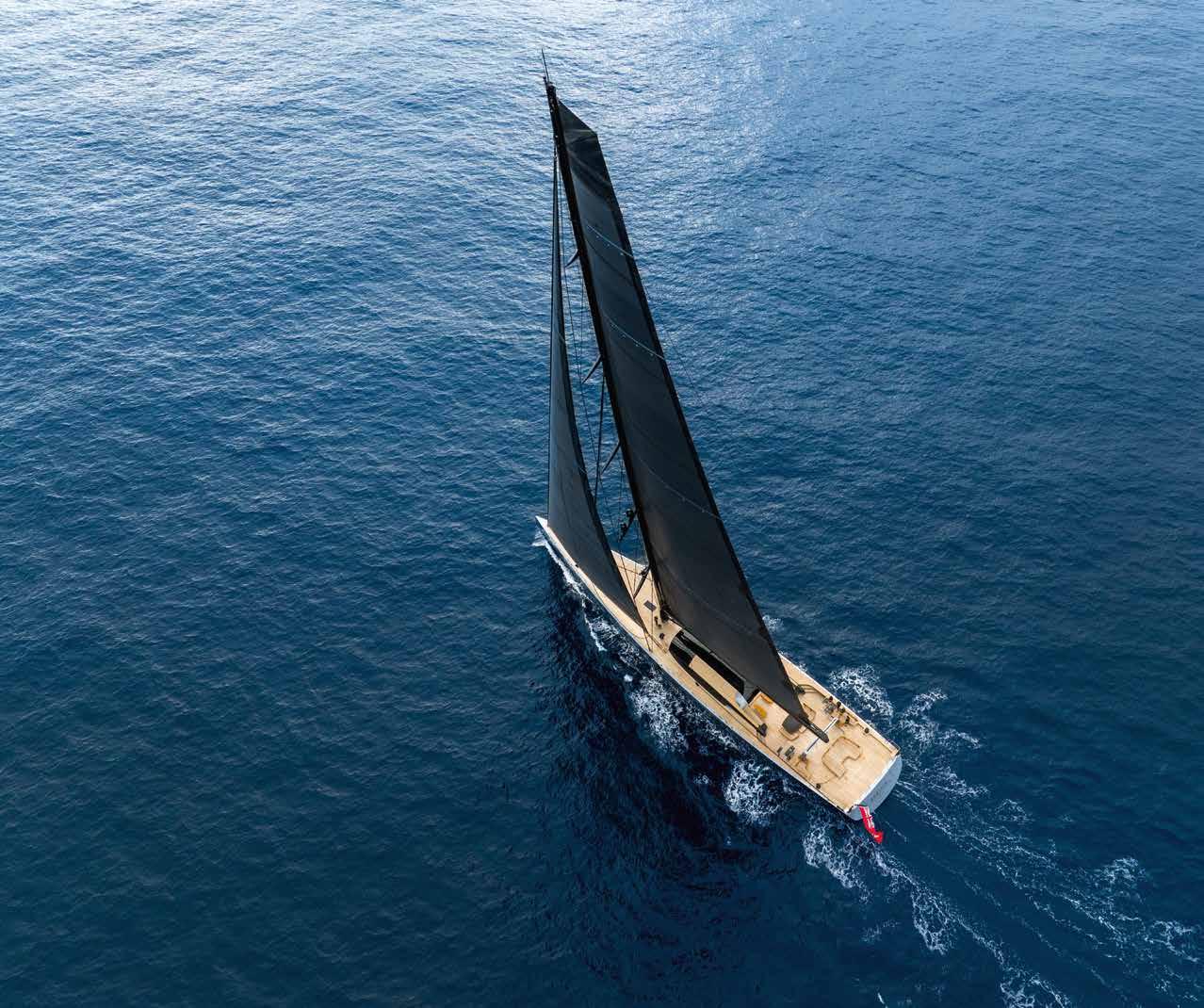The Superyacht Report
OWNERS FOCUS






Editor-in-chief Martin H. Redmayne says that after an unprecedented year for incidents involving superyachts, owners might choose different times of the year to go cruising or explore remote locations.
Ihave labelled myself @superyachtobserver on Instagram – because I suppose it’s what I do. It’s like being a yacht spotter albeit with a bit more knowledge or understanding of what is really happening in the market. But as an observer of superyachts for the past 35-plus years, with some time on board prior to this, I’ve never witnessed such an eventful year when it comes to dramatic weather and superyacht incidents, especially in the Mediterranean.
Fires on board, in shipyards and in marinas, vessels hitting rocks, beachings and groundings, big yacht collisions, bumps in marinas and, of course, significant sinkings have all made the headlines, the social-media pages and been the subject of many expert debates and much amateur speculation.
Many of these incidents have been caused by significant weather systems, ranging from excessive heat in lazarettes that may have led to overheating poorly stored batteries all the way to significant storms that have blown up in Formentera, Ibiza and Greece – and obviously the most recent devastating one in Sicily.

BY MARTIN H. REDMAYNE
When we add into the mix the variety of groundings and navigational incidents that seem to have been relatively commonplace, and where weather wasn’t involved, we have to ask ourselves what’s happening out there because with all the mini disasters, major catastrophes and insurance nightmares, you can expect that owners, potential owners and charter clients will start to ask questions.
If we look at the variety of accidents and disasters, and perhaps focus on the most high-profile event in Sicily, we have to consider some facts and figures. Every year we build several hundred superyachts over 24 metres, many of which are destined for Mediterranean cruising, with safety and integrity at the
fundamental of design and engineering. We hire, train and employ tens of thousands of crewmembers who have been through a series of mandatory training programmes to ensure they should know what they are doing when things go wrong. We have insurance policies, surveyors, yacht managers and regulators who work together to ensure that yachts are operating safely and securely in open waters. We have navigational instruments, sonars, weather routing and reporting that are typically installed on the vast majority of superyachts in order to plan the best cruising pattern and conditions.
However, if there’s a submerged rock or shifting sand bar that hasn’t been correctly mapped or updated. and if a storm blows up within minutes due to moisture-filled skies, winds and warmer than typical water temperature – these are some of the unexpected factors that cause chaos for anyone at sea.
Nature is more powerful than anyone can design or build for, and climate change has without doubt impacted the shifting sands and weather systems that we’ve witnessed over the past few years in the Med and maybe, just maybe, seamanship and real ocean experience may not be what it used to be.
Based on the facts that will come out of the various incident investigations, there will be some major recommendations and updates to rules, regulations and training curriculum, this we can be sure of, but we may also see owners and their guests choose different times of the year to go cruising or explore unique locations, when the weather systems are less unpredictable or more stable. Greece in October is absolutely beautiful, and Formentera in May is stunning … and, just saying, without the crowds of tourists. MHR
What are the multi-million-dollar questions prospective owners should be asking?
Nic Arnold, UK head of JTC Private Office, lists the priorities that should be considered by anyone before they enter the realm of yacht ownership.
Why the yacht survey report is essential reading
Richard Franklin, managing partner of Yacht Survey Partners, explains the importance of engaging with your surveyor before purchase.
Creating the custom culture
Richard Orme, founder of The Superyacht Mentor, on why reputation matters … and that the responsibility for this starts at the very top.
Optimising yacht ownership through lending
Adina Bates, head of yacht finance, and Nicolas Feit, CEO of Société Générale Private Banking Monaco, on how well-structured lending can be part of a pragmatic ownership strategy.
A challenging future for the once discreet fleet
Christophe Bourillon, CEO of the Professional Yachting Association, explains how owners can adapt to recruit top crew … and meet sustainability demands.
Eco-friendly expenditure … It all figures out
Hanna Dąbrowska, technical director of Water Revolution Foundation, explores the intersection of environmental considerations and yacht ownership costs.
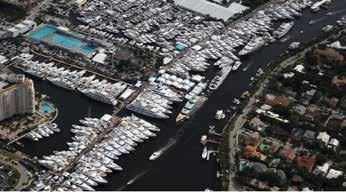
We dissect the American superyacht market, its current economic trends and the latest wealth data to determine the health of the market across the Atlantic.

A fraction of the problems
Tapping into the real potential of shared ownership models in order to draw more UHNWIs into yachting.

We explore whether an 80-metre superyacht, together with a support sister ship or shadow boat, delivers a better ownership experience than a 100-metre-plus project.

Is this new charter concept the future of yachting? 57
The new Pastrovich X-PAGODA taps into a potential market that our industry has often struggled to attract.
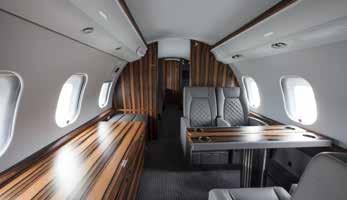
A new name to add to the spec list 74 F/Yachting has arrived to change the superyacht interiors landscape, with a clear objective as an innovator, game-changer and partner.

The development of major marina assets over the next 10 years in the Red Sea will extend the traditional cruising itinerary.
We didn’t start the fire … but are we fanning the flames?
CEO SURVEY
After a spate of highly publicised fires, both on board yachts and in shipyards, is the industry currently doing enough to take a more proactive stance and make the necessary improvements before the next disaster forces the issue?
Percentage increase of operating costs and raw material prices increased in the past two years
64
The big CEO survey 83 Market leaders in the superyacht industry reveal their current thinking as well as their ambitions for the next few years.
Sustainability: Why owners should choose, not snooze 99
How incorporating more eco-friendly practices can benefit owners and guests while not negatively affecting their on-board experience.

"Lorem ipsum dolor sit amet, consectetur adipiscing elit, sed do eiusmod tempor incididunt ut labore et dolore magna aliqua. Ut enim ad minim veniam, quis nostrud exercitation ullamco laboris nisi ut aliquip ex ea commodo consequat. Duis aute irure dolor in reprehenderit in voluptate velit esse cillum dolore eu fugiat nulla pariatur. Excepteur sint occaecat cupidatat non proident, sunt in culpa qui officia deserunt mollit anim id est laborum."
"Lorem ipsum dolor sit amet, consectetur adipiscing elit, sed do eiusmod tempor incididunt ut labore et dolore magna aliqua. Ut enim ad minim veniam, quis nostrud exercitation ullamco laboris nisi ut aliquip ex ea commodo consequat. Duis aute irure dolor in reprehenderit in voluptate velit esse cillum dolore eu fugiat nulla pariatur. Excepteur sint occaecat cupidatat non proident, sunt in culpa qui officia deserunt mollit anim id est laborum."
"Lorem ipsum dolor sit amet, consectetur adipiscing elit, sed do eiusmod tempor incididunt ut labore et dolore magna aliqua. Ut enim ad minim veniam, quis nostrud exercitation ullamco laboris nisi ut aliquip ex ea commodo consequat. Duis aute irure dolor in reprehenderit in
QUARTER 3/2024
For more than 30 years The Superyacht Report has prided itself on being the superyacht market’s most reliable source of data, information, analysis and expert commentary. Our team of analysts, journalists and external contributors remains unrivalled and we firmly believe that we are the only legitimate source of objective and honest reportage. As the industry continues to grow and evolve, we are forthright in our determination to continue being the market’s most profound business-critical source of information.
Editor-In-Chief
Martin H. Redmayne martin@thesuperyachtgroup.com
News Editor
Conor Feasey conor@thesuperyachtgroup.com
Sustainability Editor
Megan Hickling megan@thesuperyachtgroup.com
Guest Authors
Nic Arnold
Adina Bates
Christophe Bourillon
Hanna Dąbrowska
Nicolas Feit
Richard Franklin
Richard Orme
Dan Robsham
Michelle van der Merwe
COMMERCIAL
Head of Commercial
Eliott Simcock eliott@thesuperyachtgroup.com
Group Account Director
Luciano Aglioni luciano@thesuperyachtgroup.com
Head of Intelligence
Charlotte Gipson charlotteg@thesuperyachtgroup.com
Research Analyst
Isla Painter isla@thesuperyachtgroup.com
Senior Research Analyst
Amanda Rogers amanda@thesuperyachtgroup.com
Data Analyst
Miles Warden
miles@thesuperyachtgroup.com
DESIGN & PRODUCTION
Content Manager & Production Editor
Felicity Salmon
felicity@thesuperyachtgroup.com
Front cover: The new Amels 80m in an advanced stage of construction at the Vlissingen facility, due for delivery in 2025.
Photo credit: Damen Yachting.
ISSN 2046-4983
The Superyacht Report is published by TRP Magazines Ltd (trading as The Superyacht Group) Copyright © TRP Magazines Ltd 2024 All Rights Reserved. The entire contents are protected by copyright Great Britain and by the Universal Copyright convention. Material may be reproduced with prior arrangement and with due acknowledgement to TRP Magazines Ltd. Great care has been taken throughout the magazine to be accurate, but the publisher cannot accept any responsibility for any errors or omissions which may occur.
The Superyacht Report is printed sustainably in the UK on a FSC® certified paper from responsible sources using vegetable-based inks. The printers of The Superyacht Report are a zero to landfill company with FSC® chain of custody and an ISO 14001 certified environmental management system.
SuperyachtNews
Spanning every sector of the superyacht sphere, our news portal is the industry’s only source of independent, thoroughly researched journalism. Our team of globally respected editors and analysts engage with key decision-makers in every sector to ensure our readers get the most reliable and accurate business-critical news and market analysis.
Superyachtnews.com
TheSuperyachtReport
The Superyacht Report is published four times a year, providing decision-makers and influencers with the most relevant, insightful and respected journalism and market analysis available in our industry today.
Superyachtnews.com/reports/thesuperyachtreport
TheSuperyachtAgency
Drawing on the unparalleled depth of knowledge and experience within The Superyacht Group, The Superyacht Agency’s team of brilliant creatives, analysts, event planners, digital experts and marketing consultants combine four cornerstones – Intelligence, Strategy, Creative and Events – to deliver the most effective insights, campaigns and strategies for our clients.
www.thesuperyachtagency.com
Follow The Superyacht Group channels on LinkedIn
@thesuperyachtgroup
@thesuperyachtgroup @superyachtobserver @superyachtagency
Join The Superyacht Group Community
By investing in and joining our inclusive community, we can work together to transform and improve our industry. Included in our Essential Membership is a subscription to The Superyacht Report, access to SuperyachtIntel and access to high-impact journalism on SuperyachtNews.
Explore our membership options here: www.superyachtnews.com/shop/p/MH

With over 25 years of experience, we have overseen more than 150 successful new-build and refit projects in all major international yacht locations. Trust us for state-of-theart materials, cutting-edge technology and unparalleled expertise. Guarantee a flawless finish with WREDE Consulting.


With a presidential election looming, we dissect the American superyacht market, its current economic trends and the latest wealth data to determine the health of the market across the Atlantic.
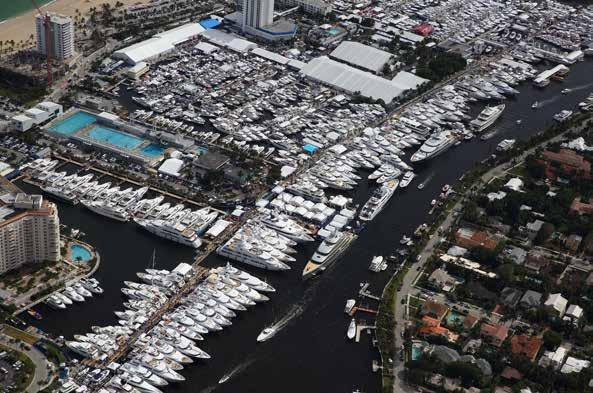
BY CONOR FEASEY
As the old adage goes, ‘If you can’t beat them, join them’. In yachting, however, it might be more fitting to say, ‘If you can’t build one, buy one’. With US shipyards struggling to keep pace with their European counterparts, American ultra-high-net-worth individuals (UHNIs) have shifted their focus to Europe – not to compete but to invest in the best. And without their influence, the landscape of our industry would be unrecognisably different.
The United States has long been a cornerstone of the global superyacht market, a trend that has only intensified in recent years. North America continues to hold the title of the world’s largest wealth sector, with the UHNW population in the region expanding by 11.9 per cent in 2023 to 161,280, according to Wealth-X World Ultra Wealth Report 2024
This growth outpaced gains in Europe and Asia, increasing North America’s share of the global ultra-wealthy demographic to 38 per cent. Collective net worth in the region also surged by 11.7 per cent to $18.6 trillion, bolstered by a surprisingly resilient US economy and double-digit equity returns, particularly from the so-called ‘magnificent seven’ mega-cap technology stocks.
Simply put, the American superyacht market has always been the largest and remains a significant source of owners and guests, but the upcoming US election presents a new wave of uncertainty. Furthermore, shifts in global wealth, geopolitical tensions and other potential political changes may reshape the industry in the coming years. So what does the changing economic landscape and the prospect of revitalised leadership mean for the US sector?
Within this context, Miami has emerged as a prominent financial hub – it’s not all Hawaiian shirts and Tom
Selleck-esque moustaches, but a place where deals are done. The city now ranks 24th on the Global Financial Centres Index and seventh among North American cities, and its rise as a financial centre has been driven by an influx of hedge funds, private-equity firms and international banks, drawn by Florida’s favourable economic environment compared to traditional financial centres such as New York and California.
“During Covid, there was a noticeable migration of businesses from other states to Florida, driven by a combination of factors,” explains Erin Ackor, partner at Miami-based law firm Moore & Co and president of the International Superyacht Society. “One significant reason, in my view, is political. Florida is run by a Republican governor, which led to policies that were quite different from those in states governed by Democrats.
“For instance, New York took a very strict approach to lockdowns, which led many people to reach a point where they felt enough was enough. In contrast, Florida’s approach was much less restrictive. Businesses and individuals were attracted to Florida because children were back in school within six months, and people were allowed to be outside, unlike in some states where even outdoor activities were heavily restricted.”
There’s also a sizeable tax difference between states. Some have a state income tax, while Florida does not. This creates a very favourable business environment because not having to pay state income tax can save businesses a substantial amount of money. In New York, for example, businesses face not just state income tax, but also local and county taxes.
“People realised they could save eight to 10 per cent by moving to states like Florida,” adds Ackor. “It wasn’t just
Following the Russian invasion of Ukraine, the resulting sanctions have effectively removed Russian UHNWIs from the majority of the industry – leaving a significant gap that North American buyers have been quick to fill.
Florida, though. A lot of companies also moved to Texas, Tennessee and other Republican-run states with zero state income tax. Miami, in particular, is very vibrant with a diverse mix of people, includingmanywealthyindividualswith the resources to buy yachts. The favourable tax environment combined with the beautiful surroundings makes it not just a place to do business, but also a desirable lifestyle.”
In light of this burgeoning financial prominence of Florida, our industry is poised to benefit, particularly as the beating heart of the superyacht industry lies but a train ride away from Miami. Often hailed as the ‘Yachting Capital of the World’, Fort Lauderdale’s renowned yachting infrastructure, combined with the wealth influx into Miami, presents sizable prospects for the industry.
“The US is an incredibly important market. It’s a crazy market, particularly at the moment,” says Jonathan Beckett, CEO at Burgess Yachts. The brokerage recently opened a new office in Miami’s Brickell area, also known as Wall Street South, in a bid to seize opportunities for new and existing owners in the region. The firm’s move to the city’s financial district to set up shop in a building that also houses tenants such as JPMorganChase and Boston Consulting Group follows the relocation of several hedge funds and tech companies.
“Ofcourse,thereisabitoftrepidation in the US at the moment regarding the election, which happens every time,” adds Beckett. “But that will be relatively short-lived and once the election is over, themarketwillmoveagain.Whenyou’ve been in the business for a long time, you simply factor [in] instances like this.”
Robb Maass, attorney at Alley, Maass, Rogers & Lindsay, adds, “Jonathan sees strengthintheUSmarketfromapersonal perspective. I think he’s refocused Burgess, not by moving away from Europe but by putting more resources and attention on the US market, which is just logical. We are an extremely wealthy country, not just in terms of average wealth, but also in terms of the individuals who have the resources to buylargeyachtsandareinclinedtodoso. There’s a lot of wealth in other countries
Data gathered from Wealth X, an Altrata company.
Note: Planes/jets and yachts worth a minimum of US$5M. Ownershop of jets can be either full or fractional. The data represents the whole UHNW population, taking into account luxury asset ownership and the size of each cohort.
Source: Wealth-X, an Altrata company, 2023.
but people aren’t necessarily as prone to buying large yachts as we are, and that’s something more and more businesses are starting to recognise.”
Miami not only holds significant concentrations of wealth, but also serves as a cultural luxury epicentre, where it’s more a way of life than a commodity. For brokers, this concentration of affluence presents a golden opportunity, and in a market where relationships are paramount, understanding the geographic and cultural nuances of wealthy enclaves is vital.
Over the years, the distribution of UHNWIs has shifted significantly across the globe. In 2005, Europe was the dominant region, housing the largest proportion of the world’s wealthiest people. However, by 2023, North America had gradually overtaken Europe and is expected to solidify its position as the primary hub for UHNWIs by 2028. The region is currently maintaining its lead, with the number nearly doubling from 81,700 in 2017 to a projected 161,280 this year. This substantial increase points to a favourable economic environment, particularly during the Trump administration, where economic policies significantly benefited the ultrawealthy, leading to accelerated wealth accumulation.
Asia has also been on a rapid upward trajectory. Although Asia’s share of the global UHNW population was relatively modest in 2005, it grew significantly by 2023. Projections for 2028 suggest that Asia will see wealth concentration levels similar to North America’s. Asia’s UHNW population is also expected to climb from 59,900 in 2017 to 110,600 this year.
On the other hand, Europe is experiencing a relative decline. Although it remains an important market, the region’s share of the world’s ultrawealthy is shrinking by comparison. Europe is expected to grow from 64,400 UHNWIs in 2017 to 111,500 this year, reflecting a stable, albeit slower, economic expansion compared to North America and Asia.
The broader geopolitical landscape has further tilted in favour of the American market following the Russian invasion of Ukraine. The resulting sanc-
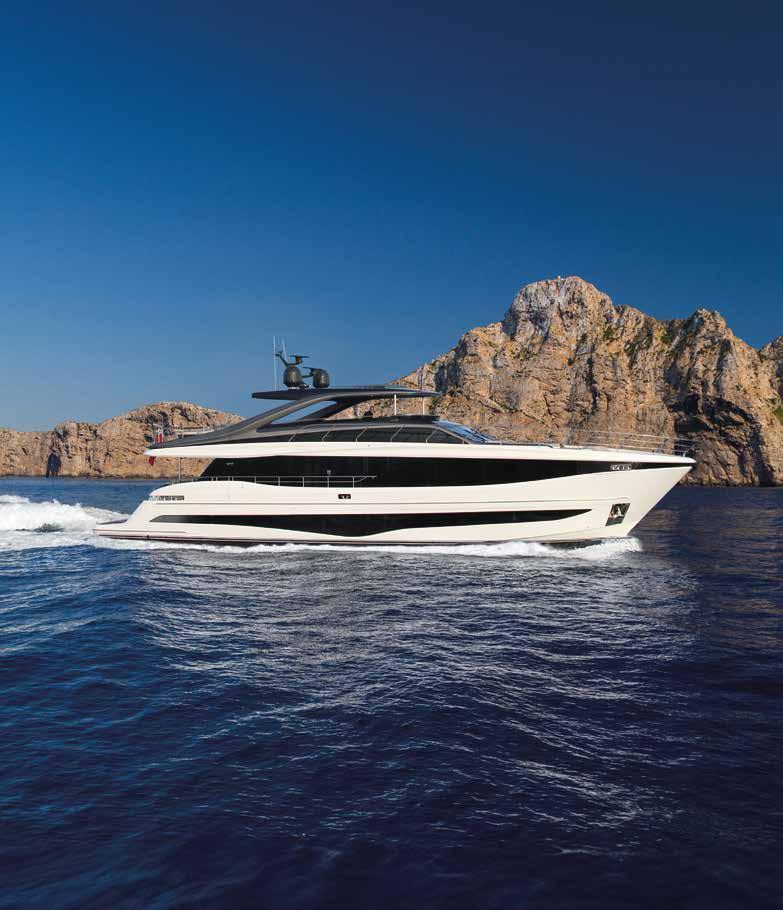
tions have effectively removed Russian UHNWIs from the majority of the industry – leaving a significant gap that North American buyers have been quick to fill. The exodus of Russian superyacht owners has also led to their share taking up 8.1 per cent, down from 9.1 per cent last year. As a result, Russian ownership has not only decreased but the nation’s influence in the global superyacht market has also waned, further enhancing the US’s dominant position.
Wealth-X data confirms that this shift has bolstered the US market. This reallocation of wealth presents both opportunities and challenges for the industry. On the one hand, American buyers are stepping up to fill the void left by Russian clients, continuing to drive demand. On the other, brokers must grow and understand a slightly new landscape, where both traditional market dynamics have shifted and expectations of buyers have evolved. Understanding these nuances will be key to capturing the emerging opportunities in an already competitive market.
“The market has changed dramatically, and global wealth has increased significantly, says Maass. “This trend is expected to continue, with wealth continuing to rise worldwide. However, it doesn’t follow a straightforward upward trajectory, it’s more like a roller coaster, with peaks and valleys. But overall, the trend remains upward, and that translates to more people being in a position to purchase large yachts.”
Some in the industry have been more affected than others. Beckett explains that the loss of that demographic landed a weighty blow to Burgess, with the company losing 20 to 25 per cent of its clients seemingly overnight. “It’s about working harder in those markets,” says Beckett. “But this is one of the reasons I’ve gone to America: to rally the troops and perhaps recruit more people committed to making a real impact over here. The harder you work in the marketplace, the more success you have.
“As a broker, understanding the nuances of different cultures and people is key. For instance, Americans tend to

YOUR YACHT DESIGNED, ENGINEERED, CRAFTED. YOUR WORLD
A unique shipyard is defined as a shipyard to make at least one delivery in that calendar year.
Cumulative number of annual deliveries of the four most prominent US shipyards since 2000
In terms of the US fleet delivered since 2000, Palmer Johnson Yachts and Trinity Yachts have been dominant players. However, it should be noted that both builders ceased operation in 2016.
Westport continues to be the main contributor to the US fleet, delivering an average of five yachts a year since the turn of the century. Unique US shipyards
be more enthusiastic about doing deals. They typically have more of a hunger and an appetite for closing a deal, and like credit. Europeans, on the other hand, are more cautious when approaching a deal and also tend to shy away from financing a yacht.”
Therefore, in tandem with the highest number of UHNWIs, it will come as no surprise that the US leads in ownership too, with 23.6 per cent of the world’s superyacht owners residing in the US as of 2023, an increase of 0.6 per cent from the previous year. The country’s preference for larger vessels is also on show, with an average length of 54 metres.
However, the prominence of American owners hasn’t translated into a thriving domestic new-build industry. The 1990s and early 2000s were periods of growth for superyacht shipyards in the US, with builders such as Westport, Christensen, Palmer Johnson and Trinity Yachts at the forefront, delivering some of the world’s largest and most highly acclaimed boats. But by 2008, the industry had hit the peak of its golden age before experiencing a sharp decline, largely due to the global financial crisis.
There was also a significant shift in the euro-dollar exchange rate, which at one point was close to 1.6. It’s now around 1.12 but back then, European builds were much more expensive for Americans, giving US builders a price advantage that’s since disappeared. That shift completely changed the market. “The American market at the moment is the European market when it comes to new yacht construction. More and more Americans are entering contracts to build boats in Europe,” says Maass.
“It’s much less of an Americandominated world in this industry now. We have very few yards still building
large yachts, although we do have a lot of production builders. In terms of the number of boats built, if you include everything from bass boats to superyachts, we’re still number one in the world, but when it comes to large yachts, we’re just a fraction of what we used to be.”
Unlike other sectors that rebounded a few years after the financial downturn, the US new-build sector has struggled to return to its former production levels, with signs of recovery still elusive, according to Superyacht Intelligence data. By 2016, both Palmer Johnson and Trinity Yachts had ceased operations, and Christensen’s output had significantly diminished. The high costs of launching equipment and the geographic challenges of American shipbuilding further compounded the industry’s decline, leaving US shipyards struggling to compete with their European counterparts.
The decline of American shipbuilding aligns closely with broader deindustrialisation trends seen across the US. Since the mid-1990s, shipbuilding in the US has diminished exponentially, which has directly affected the superyacht industry and is vividly illustrated by the slump in deliveries and the number of active US shipyards. In 2008, at the peak of the market, US shipyards delivered 34 superyachts with a total length of more than 1,368 metres. However, by 2023, this number had plummeted to just two deliveries, with a combined length of only 76 metres.
The drop in the number of active shipyards from 16 in 2001 to just one as of 2021 poignantly hits home the dramatic contraction of the industry. While Delta Marine continued to make a small number of deliveries until 2020, it hasn’t built a boat since, although it
Robb Maass, attorney, Alley, Mass, Rogers & Lindsay.

“I think American manufacturers could easily bring in some European talent but it’s very difficult to establish a new yard capable of building boats to the same quality you see in Europe overnight.”
is predicted to deliver a 44-metre yacht in 2025. Westport continues to be the major US shipyard, although production has slowed, producing an average of five yachts a year since the turn of the century.
This trend is exacerbated by the lack of subsidies and supportive economic policies in the US, making it difficult for domestic shipbuilders to compete on a global scale. Some countries continue to invest in their emerging industries through targeted initiatives. For example, the UK government has launched a new financing plan to support domestic shipbuilding, including yacht and superyacht yards. The Shipbuilding Credit Guarantee Scheme (SCGS) is a key component of this effort, where the government acts as a guarantor for up to 80 per cent of a shipping loan.
The US government has failed to provide similar levels of support. The Jones Act further complicates matters by adding costs to US-built yachts, requiring goods transported between US ports to be carried on American-built, Americanowned and American-operated vessels. This legislation has increased the cost of transporting yachts within the US, making domestic shipbuilding less competitive.
“Now [that] European boats are less expensive relative to American-built ones, the decision of where you’re going to build your yacht tends to be an easy one,” says Maass. “If the euro rises, that could change, and we might see growth in the domestic market in America again. But it’s unclear if that will happen. Once these yards go under or are repurposed, it would take a lot to regenerate that manufacturing capacity.
“It also would take a prolonged period of higher euro rates to make a significant difference, but I don’t see that happening any time soon. In a world that’s increasingly volatile, the
dollar remains the refuge currency. In fact, there’s more US cash, particularly hundred-dollar bills, in circulation outside the US than within it. Under these conditions, it’s unlikely we’ll see a radical shift in exchange rates.”
There’s also a prevailing belief among some owners that European-built yachts are of superior quality, which has diverted attention away from USbuilt vessels. This perception is then reinforced by economic factors such as the exchange rate between the euro and the dollar, making European yachts more financially attractive to potential buyers. Changes in the tax code, particularly those affecting income and luxury taxes, can also deter potential superyacht owners. Moreover, tariffs on imports to the US increase the cost of materials, pushing up the final price of a vessel and making US-built yachts less competitive. Maass vividly recalls a conversation he had with Paolo Vitelli, founder of Azimut Yachts, more than 30 years ago, just after he acquired Benetti. “He said that his dream, when starting out, was to build more yachts than Broward.” A dream that he has no doubt since achieved.
Maass adds, “US builders have had to fight the perception that European yachts are of a higher quality. Once that perception exists, it takes a long time to dispel, and right now, it’s not particularly relevant because there aren’t many US manufacturers prepared to compete with European builders. I don’t want to say there aren’t any. For example, Delta is still building and they produce very high-quality boats.
“It will be difficult fort he US builders to come back. One of the problems is that when you have such a significant drop in capacity, your skilled labour goes off into other industries. The knowledge and experience gained from working in a shipyard for 30 years is something you can’t just replicate instantly.”
Leading provider of luxury outfitting for yachts, hotels, private aircrafts and homes.


We offer a complete customer experience with historical purchase information, billing and quotations. Enabling a simple reorder process and removing the need for multiple suppliers.
Reduce shipping costs by benefitting from our courier discounts. Pay lower prices utilising our bulk ordering buying power.


We can arrange storage and ship whenever it is convenient for you.
Our interior designers will help you with all aspects of a project. From reviewing the finer details to implementing a major refit. Our graphic designers will assist with branding, logos and supporting artwork.


Backed by 20 years of experience in the yachting industry, we have the best brands, equipment and expertise available to deliver results for our clients.



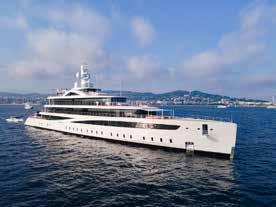




European builders have been doing well for decades, working with subcontractors and suppliers who have also been in the industry for a long time. You can’t just snap your fingers and recreate that. While importing talent from abroad could be a solution to boost the domestic market in the US, it’s not a straightforward option.
“For instance, I know that some Chinese builders have brought in nonChinese middle-management types to assist with production, which is crucial because they oversee the younger labour force, and their supervision is probably the most important factor,” says Maass. “I think American manufacturers could easily bring in some European talent but, again, it’s very difficult to establish a new yard capable of building boats to the same quality you see in Europe overnight.”
Although the current state of the American new-build sector remains bleak, there are ways for the industry to reverse the decline. The simplest step is to communicate and show the market the quality of vessels that American builders produce. But to truly revitalise the industry, stakeholders need to take collective action and advocate for legislative changes that will support the sector to make it happen – and with the US election looming, that opportunity could be on the horizon.
The upcoming election adds an extra layer of complexity to the fabric of the American market. Initially, many around the world anticipated a return of Donald Trump’s presidency because the polls seemed to favour the former businessman over current President Joe Biden. However, with Kamala Harris now the Democratic candidate following Biden’s decision to step down, the landscape has dramatically shifted.
“What I’m observing in my practice is a definite slowdown as we approach the election,” says Ackor. “Now there are likely several reasons for this. The wars in Europe, particularly the conflict between Ukraine and Russia, and the situation in the Middle East with Israel, are certainly not helping. These events are understandably unsettling. Then the uncertainty surrounding our political landscape and the upcoming elections is contributing to this slowdown.
“When Trump was leading by a significant margin, things seemed to stabilise somewhat. But now, with so much uncertainty, people are holding off. It’s very clear to me that transactions have slowed but I don’t think it’s because people lack the money. It’s more that they want to see what’s going to happen.”
The economic policies of Trump’s presidency had notable effects on the wealth of the industry’s primary clientele, which in turn influenced the superyacht market. Post-election, the US economy experienced a surge in business confidence due to expectations of favourable economic policies under the Trump administration, with the Dow Jones Industrial Average rising by 4.2 per cent in just two months after his inauguration.
A key piece of legislation from his tenure was the Tax Cuts and Jobs Act of 2017, which lowered the corporate tax rate from 35 per cent to 21 per cent. This was intended to stimulate economic growth by increasing corporate profits and encouraging investment. However, it’s important to note that while these tax cuts did benefit the wealthiest individuals, the broader impact on the economy was more modest.
In terms of what this meant for the superyacht industry, this policy not only boosted corporate profits, but also
“While I think Trump has been a disaster for America, damaging our international reputation and lowering our standing in the world, from a yachting perspective, he likely represents a better outcome in the election than Harris would.”
led to increased stock buybacks, further elevating share prices across the US. It meant that many potential buyers –who are, more often than not, business owners or major shareholders – saw a significant rise in their wealth, thereby enhancing their ability to invest in, and purchase, assets such as yachts.
There’s also a whole sector of young people involved in the cryptocurrency environment. Trump is, if not very procryptocurrency, at least supportive of it and is also pro-deregulation, which contrasts with the Biden-Harris administration which is much more focused on regulation. We could speculate that a Harris administration could still support a new era of superyacht buyers but marked by increased environmental consciousness. However, the potential for tax reforms and heightened economic uncertainties is more likely to lead initially to a more conservative approach to spending, affecting how and when UHNWIs decide to invest in the industry.

people are in a holding pattern. I have many clients with boats for sale and nobody is buying all of a sudden. This seems to have started in the last two or three months. There was also a bit of a blip when Trump’s poll numbers shot up and people thought he was going to win.
“Things seemed to normalise for a while and we started seeing more transactional deals come through. But now, everything has stopped again. When times are great, we have a busy transactional department, and similarly, when times are tough, we have a booming litigation practice.” And the latter seems to be the case at present, she says.
There are also fears of what it would mean for the supply chain and the wider industry in the US if Harris was to hike taxes. “I would be concerned that businesses that feed into the industry would be hit very hard by tax increases,” says Ackor. “With increased taxes and regulation, it becomes really difficult to sustain a small business. The superyacht industry feeds into so many livelihoods, and that’s one of our biggest strengths. The economic impact we have on communities, especially in South Florida, is massive, with so many people working in the industry. If these small businesses are taxed more heavily, it would be a real challenge.”
For Ackor, more regulation and higher taxes won’t help the situation. In terms of what she sees in her practice, from a purely economic standpoint, a Trump administration would likely lead to greater stability, a more vibrant economy and more opportunities for people, and with a booming industry there’s more opportunity to innovate and solve issues that the industry faces in other areas.
“We don't know what Harris is planning policy-wise,” says Ackor. “It’s interesting because, in my opinion,
“If Trump gets elected again, I think we’ll see a boom. When people see the economy stabilising, it gives confidence to the markets, and that’s where you see the superyacht industry flourishing.”
Ackor adds, “If Trump gets elected again, I think we’ll see more of an economic boom. When people see the economy stabilising, it gives confidence to the markets, and that’s where you see the superyacht industry flourishing. There’s more money being made. The superyacht industry as a whole provides significant economic support to so many, and it’s important that we take this into consideration.”
Maass reluctantly agrees, but only up to a point. “I have mixed feelings about this because while I think Trump has been a disaster for America, damaging our international reputation and lowering our standing in the world, from a yachting perspective, he likely represents a better outcome in the election than Harris would.
“However, even though this is my business and my industry, I believe there are other reasons why we should be considering someone other than Trump. It’s not all about the wallet. There are intrinsic values that are extremely important. I don’t believe in people voting solely based on their financial interests.”
Erin Ackor, partner, Moore & Co and president, International Superyacht Society.
Worldwide economic factors have a part to play too. Recent stock-market activity witnessed severe fluctuations, which could be a cause for concern. In early August this year, global markets experienced a sharp downturn, largely triggered by Japan’s decision to raise interest rates, which led to the unwinding of the yen carry trade – a strategy that investors had relied on for stability. This, combined with disappointing US
jobs market data, which showed much weaker growth in non-farm payrolls than anticipated, spurred fears of an impending recession.
For yachting, this market instability could have several implications. Historically, fluctuations in the stock market have directly impacted the purchasing power and investment behaviour of UHNWIs. Therefore, a prolonged period of market volatility, such as the one we’re currently seeing, could be another reason leading to more conservative spending patterns among these individuals, dampening demand for yachts. The full impact will depend on whether these recent market disturbances mark the beginning of a longer-term trend or if they are primarily driven by short-term factors.
“So far, however, at least for us, it really hasn’t had much of an effect. We’ve been involved in a number of very large new builds this year. But what I’ve always said is that buying a boat isn’t necessarily about money,” says Maass. “There’s always money out there. There’s a tremendous amount of wealth in the world, and a lot of it is still untapped when it comes to the yacht market. What causes a person to buy isn’t whether they’re able to, but whether they’re in the right frame of mind. It’s more about psychology than ability. In times of volatility or uncertainty, that mindset can change.”
Regardless of the election and economic volatility, Ackor maintains that collaborating across the industry is key, and tackling issues that face our industry directly head on should remain our focus. “Superyacht owners are key, and they’re generally very interested in finding ways to be more environmentally conscious,” she says.
“At the moment, we have a lot of resources and superyacht funding, but that will change over time. The US won’t
Regardless of the election and economic volatility, collaborating across the industry is key, and tackling issues that face our industry directly head on should remain our focus.
always be the leader in yacht ownership. Things shift globally, and there are many owners in places like England, which has a significant yacht ownership population. We’re also looking at emerging markets like China, the Middle East and others. But we need to figure out how to work productively with these markets and promote sustainability together. Yacht owners are leaders and innovators and have the wealth behind them to help us effect change, including developing more sustainable solutions for the future.”
Despite some trepidation, many remain cautiously optimistic. Wealth is expected to continue its upward trajectory and having navigated previous economic storms, the industry is likely to follow suit. As the brokerage sector expands across the US, increasing exposure to the benefits of yachting, the market stands to gain from this momentum. And although current economic and geopolitical factors will continue to contribute to volatility in the market, staying informed and
drawing lessons from past experiences will all but secure the industry’s future in the United States and beyond.
“This year is softer due to the American election, the election in France, the war in Russia and Ukraine, and the Israel-Gaza conflict. The economy in Europe is also a bit shaky. But the US and global brokerage sector is in a good place, though it may not reflect the same highs of the last two exceptional years,” explains Beckett.
Maas concludes, “As the saying goes, ‘It’s the economy, stupid’. If people are confident, they will buy. It’s a matter of psychology. If the world calms down a bit, people will buy more. But if we end up with more regional conflicts, especially in the Middle East, and if the situation in Ukraine continues, those are not good factors. So we have to watch that. However, if you look at things over a longer time horizon, I believe the yachting industry still has a bright future.” CF
All analysis was undertaken by our data and research consultants. We provide bespoke consultancy projects that help clients make informed, data-driven decisions. Scan the QR Code to see examples of our work.
by Nic Arnold
Nic Arnold, UK head of JTC Private Office, lists the priorities that should be considered by anyone before they enter the realm of yacht ownership.
Are there many other assets that have the emotional draw of a yacht? Whether it be a longstanding childhood dream, the prize of many years of hard work or the desire for an oasis away from the prying world, these motivations connect an owner to their yacht in a way that happens with few other assets – bar, perhaps, the business or ventures that have often generated the funds required to buy these expensive pinnacles of wealth.
And here lies the rub. What can be missed when bringing a superyacht into an owner’s life is that while their complexity, financial commitment and propensity for risk is akin to the operation of a business, the level of strategic governance usually applied to running a business is rarely applied to superyacht ownership.
I’m not referring solely to the day-today operation of the yacht which, with an experienced captain and reliable yacht manager, should be perfectly manageable. It’s the bigger picture that often needs factoring into the decisionmaking process before getting into this mad, mad world of yacht ownership. So what questions should a prospective owner be asking themselves?
The questions should not only be considered in terms of the operations of the yacht, but also the complexities of the world through which it will sail and the nuances of the family into which the yacht will arrive.
When it comes to the yacht’s operations and buying or building a yacht, the fundamental question is: ‘Am I asking the right question, of the right person, in the right place, at the right time?’
Prospective owners are busy people with a myriad of other things to focus on and sometimes do not equip themselves with enough initial knowledge to ask the right questions to challenge and hold the people they are dealing with to account in a way that will work for them personally.
Depending on the situation, an owner will be dealing with a wide range of advisers: a yacht broker, ownership structuring corporate service provider, specialist yacht lawyer, corporate lawyer, Flag state representative, specialist VAT and customs tax adviser, personal or family tax adviser, yacht charter broker, yacht manager, the captain, yacht crew employer and consultant, local tax agents and
reporting representatives and yacht insurance broker. If embarking on a yacht build, the owner can add in the shipyard, a yacht build consultant or project manager and naval architect, among others.
That’s quite a list! And I list it to make the point that there’s a lot of information from a lot of people who may cover multiple jurisdictions. Yachting is a bespoke business. Even with a production yacht, the way it’s going to be used and what the owner wants to get out of the experience will be unique to them. There really is no one size fits all and, therefore, owners need to ask themselves how they are going to get what they need out of these advisers and generate a feeling for whether they are being told what the adviser knows just because it’s what they know or that it’s actually the right answer for the owner.
Where to start? A prospective owner should ask themselves if they are buying a yacht capable of only being funded and used by them. Or is their dream to have something bigger that requires chartering to third parties to raise additional funds? Where do they want to enjoy their yacht and how
much of the globe do they expect to visit with it?
These fundamental questions will drive the conversation on the yachting experience the owner will have before even getting to the question of yacht design and functionality. If the owner doesn’t know the answers, they should keep talking and researching, and if they think it will be a combination, they need to understand up front what this looks like as it will materially impact the complexity of their arrangements. Another part of the complexity of owning a yacht is that it moves. This might seem obvious, but it means that an owner needs to look beyond the yacht as to how it will function in the various jurisdictions it will visit and consider the complexities of the world through which it will sail.
Whether choosing a home port, the location for maintenance and refits, cruising grounds or chartering locations, it’s important to ask the question: do I understand the status of my yacht and what this means in any given location? The additional challenge is that rules and attitudes change and so asking
these questions once doesn’t mean they don’t need to be asked again. Many of these questions will relate to taxation and the rules applied by the yacht’s Flag state. In particular with taxation, cross-referencing the answers received from multiple sources will help guard against working with outdated or incorrect information.
One might say that these considerations are relatively technical and manageable and can, to a certain extent, be delegated to trusted advisers within the family office or a family consultant with the right knowledge. However, questioning the impact of bringing a superyacht into family life speaks to the wider values and characteristics of the owner and their family, and one should consider the nuances of the family into which the yacht will arrive.
The ‘burden of wealth’ is a thing and is generating questions around how families interact with their wealth more than ever as the tide of newly generated capital starts to pass to the next generation.
The ‘burden of wealth’ is a thing and is generating questions around how families interact with their wealth more than ever as the tide of newly generated capital starts to pass to the next generation.

Thinking through how the yacht will be used – and who will enjoy it – will help to make it a more sustainable asset within the family. Is the new owner assuming that it will be a popular central meeting place for family holidays and celebrations, whereas the immediate impression of the next generation is that it’s an outdated expression of planet-busting excess? Would bringing the whole family into the upfront decision-making on choosing the yacht enable everyone to come together in a middle ground? Or does the owner have no expectation of anyone using the yacht other than themselves, counter to the assumptions of the rest of the family? Yachts really can bring a family together or create cracks between them.
As a possession of passion, a yacht can represent a heart-breaking asset on the death of a family principal. Does the next generation keep it, along with all the running costs, as a nod to their parent’s legacy? Or is the yacht sold immediately as they never connected to it in the way their parents did? Yachts are becoming assets considered up front in this way alongside the rest of the family’s succession and governance planning.
So, in summary, I haven’t thought to list the questions an owner should ask in order to challenge whether they should have a yacht or not. Deciding to buy a yacht isn’t a particularly logical decision in the first place. I merely seek to raise awareness of the questions that should be asked to ensure that bringing a yacht into an owner’s life is done with as much governance as possible and in a way that works for them personally as the owner. This way the old adage of the second-best day of an owner’s life being the one they got rid of their yacht can be a thing of the past. NA


With an expected dramatic shift in wealth and a generational shift in attitude towards superyachts, it makes sense to tap into the real potential of shared ownership models in order to draw more UHNWIs into yachting.
BY MARTIN H.
Globally, the wealth numbers are consistently increasing and for the past couple of decades we’ve analysed the number of buyers/owners in comparison with the number of potential clients. The conclusion is that we are still only scratching the surface. The usage data also makes interesting reading, where owners and their guests potentially spending only 10 to 20 per cent of the year afloat.
Looking at the evolution of our industry, there’s still a fixation on the billionaire category and the larger yachts in the fleet (above 50 metres), but there’s a very exciting and interesting market between 24 and 40 metres. These are, and always have been, the feeder sectors to the market. Yes, there have been some new UHNWIs jumping straight in at 60 metres-plus but it’s not a constant flow. The majority of buyers seem to move up the ranks from the entry-level superyachts and grow with their wealth and experience.
So the big question is: Where is the market heading when it comes to buying and owning yachts? Having discussed the topic with various owners over the years and met charter clients who have decided that owning is not for them, there’s a consensus among those with the potential to buy that the capital required versus the asset usage and the operating costs doesn’t always add up.
One very well-known and experienced owner explained that if you can’t use your yacht for more than 10 weeks a year, it’s wise to charter for those 10 weeks and remove any of the headaches or distractions, and use your capital for other things. Obviously, he’s right and this is definitely one of our barriers for the future. We’ve seen a variety of new buyers jump into to the market over the past few years during Covid, deciding
that owning a yacht was a great idea; safe, secure, private, a personal bubble were the common terms. However, it became apparent that some of those buyers realised they had underestimated the cost and the fact that it’s not always straightforward to get on board and enjoy their new toy often enough to justify the CAPEX/OPEX.
Over the past two decades, we’ve looked at the world of real estate and private aviation, even the luxury automotive sector, and the emerging trend is actually not to own but to have access with flexibility. There’s a new generation of UNWIs and HNWIs who may own their primary residence, or perhaps two, but have recognised that owning multiple properties around the world is expensive and demanding, even though their property may be a good investment.
In conversation with an owner who recently sold a dozen properties across the globe, he realised he was employing hundreds of staff and paying hundreds of thousands in maintenance and security per annum, but only staying in each property for a few days or weeks, leading to the decision to sell. The good news is that he bought a large yacht and is currently enjoying a round-the-world tour for a few years.
If we look at private aviation, there are about 300 smaller-body jets built each year plus 20 larger private jets entering the market from the handful of builders. The majority enter operator programmes such as VistaJet, Victor and NetJets, where the market has been driven by a demand for private air travel. Customers and operators recognise that the OPEX/CAPEX doesn’t make sense and we’ve therefore seen a boom in private travel because the model makes more sense to a bigger market potential.
Buying access or hours of use when you need to get from A to B has created very successful business models and a market dynamic where the assets are no longer sitting on the tarmac because there’s always customer who wants to buy time on board.
The evolution of asset use, where you no longer want to tie your capital up in a large asset, is starting to make sense and, by definition, offers more flexibility, more access to multiple opportunities and frees up cash to invest elsewhere. So perhaps the future of yacht ownership will start to evolve in the same way.
The numbers start to make sense when breaking down and analysing the yachting CAPEX/OPEX. A €20million investment in a smaller semi-custom superyacht with a €2million operating budget, for a programme that delivers 10 weeks per annum of private use and maybe six weeks of charter operation at €100,000 per week becomes an expensive operation. Those 10 weeks of private use end up costing €140,000 per week. Add in the capital cost and the depreciation, plus other distractions of management and crew, and this won’t make sense for some buyers.
With over 400,000 UHNWIs and many more HNWIs in the world today, all of whom are changing their buying habits and have a wide cross-section of passions and pastimes, it’s becoming harder to compete with an asset class that is never perceived as an investment and tends to just cost more money than you thought or were told.
Over the past few years we’ve done some strategic research for investors and owners on future models for ownership and asset use. We have seen more and more programmes emerge where builders and investors are developing shared-ownership programmes and
fractional offerings that deliver a smarter approach. Essentially, less capital and less cost for just enough use when you need it.
Yes, these programmes tend to be focused on the smaller end of the superyacht spectrum, where a millioneuro investment can deliver access to a 30-metre yacht for 25 per cent of the usable time per annum, with a fixed operating cost of only €240,000, but when you do the maths, for those who would typically spend €t10 million or more on a 30-metre yacht, this suddenly looks interesting.
If you look at yachts above 50 metres and apply similar numbers and economics, it starts to look as though a charter programme makes financial sense. If there are 24 weeks of cruising available and four owners with eight weeks each (perhaps the average amount of time some owners spend on board), dividing the CAPEX of, say, €60 million by four – it all starts to add up. €15 million per owner, eight weeks of use, 25 per

cent of all operating costs (assuming €3 million per annum) for, say, an average of five years, gives you €468,750 per week of ownership cost. If you’re the 100 per cent owner and invested €60 million in CAPEX and €15 million in OPEX, using the yacht for, say, 12 weeks a year, the cost per owner week jumps to €1.25 million.
Having watched the evolution of the private jet market and now the luxury villa and residence market, where wealthy clients are buying fractions of use or access to a global network of assets, it’s inevitable that superyachts will one day follow suit because the 400,000 wealthy individuals who have decided not to own a superyacht are more than likely to be in a jet-use programme or some form of
Having watched the evolution of the private jet market and now the luxury villa and residence market, where wealthy clients are buying fractions of use or access to a global network of assets, it’s inevitable that superyachts will one day follow suit.
vacation residence plan such as the Four Seasons Residences.
Another benefit to some of the ownership programmes, where you’re no longer the individual ultimate beneficial owner (UBO), is an increase in privacy, and perhaps anonymity, due to structures and asset use. Flying with Victor or Vista Jet is clearly an intelligent approach, saving time, money and being much more discreet than having your name splashed over X with your flight tracker data from your excessive private jet use there for all to see.
It’s highly likely that with the right investment plan and a well organised fleet that buying access to a yacht in all the right places without all of the risks and headaches will become a key driver of our future market. We will experience a dramatic shift in wealth and a generational shift in attitude towards superyachts, so it makes sense that investors, private equity and venture capitalists start to look more closely at the real potential of big yachts as a new fraction model.
Rather than hearing the old adage that ‘no one needs a yacht’ or the more recent ‘only buy a yacht if you can afford to give it away’, perhaps the time is right for the smart money to create a business model and ownership programme where every UHNWI can have access to a yacht. After all, using a yacht is the fun part, if everything is organised, well managed and taken care of. Owning a yacht is sometimes where the fun stops. MHR

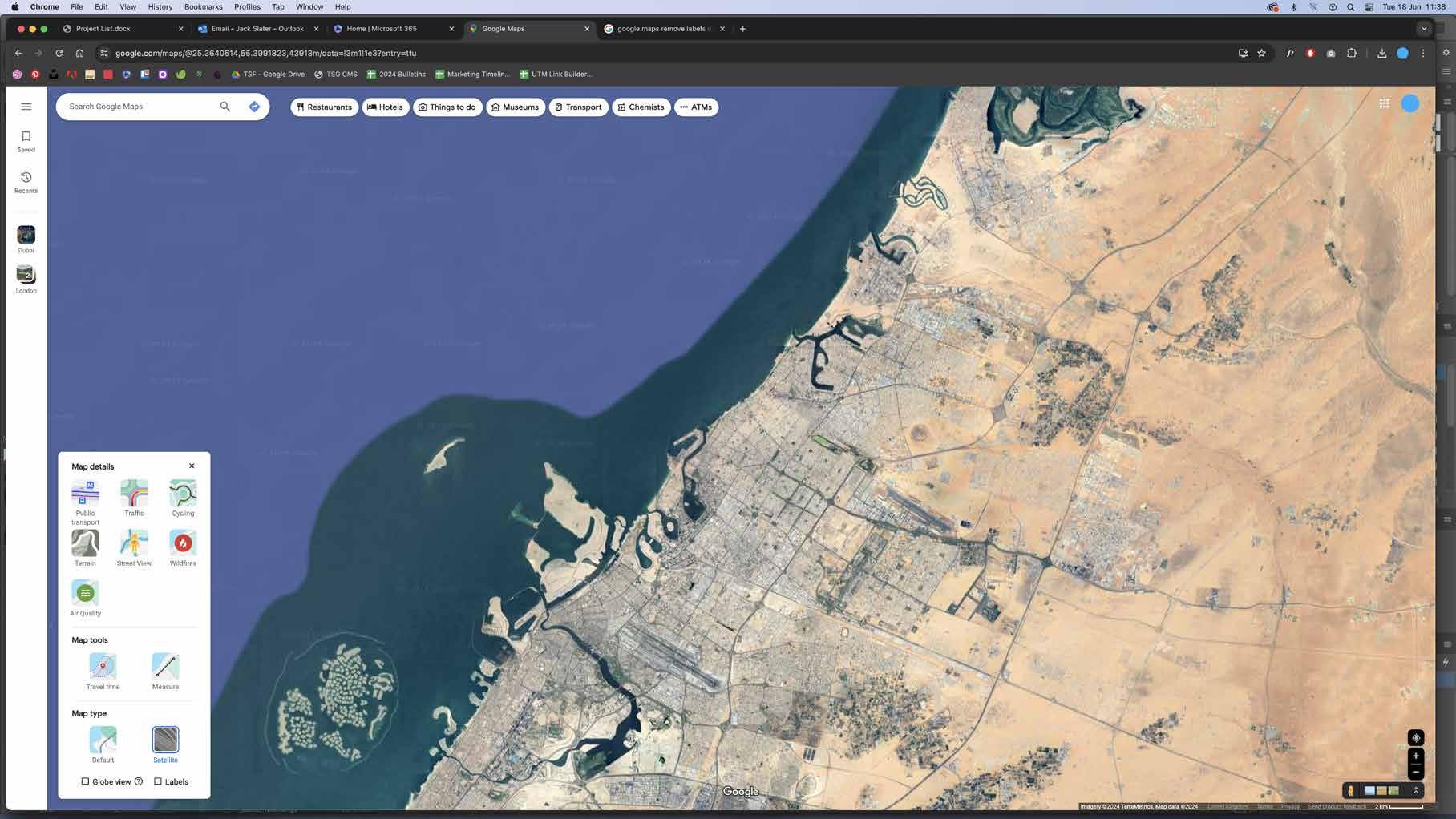


by Richard Franklin
Should you read your survey report? Yes, of course, because one way or another it will cost you time and money if you don’t read it and understand the key conclusions.
For pre-sale, pre-delivery and insurance surveys, there’s generally more time for the client’s advisors to engage with the surveyor to ensure the client is fully aware of its conclusions, recommendations and cost estimates, and for them to filter the essentials back to the owner. Here, we are focusing on pre-purchase surveys because this is when the stakes are highest and where the buyer will need to make key decisions within tight deadlines.
Only the pre-purchase survey takes place within a legal context, this usually being the MYBA Memorandum of Agreement (MOA). The key areas of the MOA that are of interest to us are clause 17 (sea trial/condition survey), which sets out the buyer’s right to conduct a survey and sea trial; clause 26 (sea trial), which states that the buyer has the right to reject the yacht without reason within 24 hours of concluding the sea trial; and clause 27 (condition
survey), which sets out the options open to the buyer within seven days of completing the condition survey.
The technical sea trial allowed under clause 26 is the surveyor’s opportunity to ensure that everything that should function does indeed function as required and to record all key operating parameters. Our detailed sea-trial protocol usually requires at least four hours (or more if there are noise and vibration specialists on board), during which the surveyor will ensure that the yacht meets expected performance criteria.
While we don’t try to replicate original sea-trial tests, we do want to explore the yacht’s capabilities and limitations. In doing so, the engines will be kept running at full power for an extended period and turning manoeuvres will be undertaken that exceed anything that might be experienced during normal operations. Why? Because where problems are going to present themselves, this is when they will become apparent, nine times out of ten.
Our sea-trial report covering the performance of each system forms
part of the final survey report and is essential reading for the buyer. If there are concerns, it’s the buyer’s easiest opportunity to reject the yacht based on its findings. Once the process progresses beyond the sea trial, options become more limited as explained below.
The condition survey allowed under clause 27 is the surveyor’s opportunity to examine in detail every aspect of the yacht that couldn’t be covered during the sea trial. The 150-plus points we examine in detail build a clear picture for the buyer of the condition of each and every system and structure on board and, where there are nonconformities, to define the remedial work required and provide an estimate of the likely cost to rectify any such non-conformities.
In doing so, we pay particular attention to any items that are classed as ‘defects’ within the meaning of clause 27, which defines defects as ‘affect(s) the operational integrity of the vessel, or her machinery, or her systems, or renders the vessel unseaworthy’. Once we’ve defined a non-conformity as a
defect and certified it as such, clause 27 states that the buyer has three options: to require the seller to rectify the defects at their own expense, or agree a commensurate reduction in price or, if neither can be agreed, for the MOA to be terminated.
For this reason, if the buyer finds time to read nothing else within the survey report, it should be the list of certified defects, together with the estimated cost to rectify them. These should form the
basis of their post-survey negotiations and, ultimately, whether or not the transaction succeeds or fails.
All the above assumes that the buyer has little time or wish to engage in the detail of the survey, but sometimes the opposite is true. Certain clients want to understand as much as they can about their proposed purchase. Some have even been known to read a surveyor’s report in full! Admittedly this is unusual, and even I struggle with
As much as reading the report, it’s what can’t be read in the report that’s important, and the buyer should spend some of their time on their sea-trial meeting the crew and visiting the engine room because they’ll quickly get a sense of how the crew cares for the yacht.

reading the hundreds of pages as I edit each report prior to sending, so these are our recommendations for where to direct the buyer’s attention, given the opportunity.
The buyer should be digging into the service history for all the major machinery because regular care and maintenance is key to performance and reliability. As much as reading the report, it’s what can’t be read in the report that’s important, and the buyer should spend some of their time on their sea-trial meeting the crew and visiting the engine room because they’ll quickly get a sense of how the crew cares for the yacht. We also advise checking the spreadsheet and survey web portal carefully, working out how much it’s going to cost and what the priorities should be.
So, in summary, do read your survey report, get comfortable with the numbers and look at the yacht through your surveyor’s eyes, but while you’re on board, chat with the crew and ask them to take you into the areas where you wouldn’t usually be taken to. You’ll soon see what the surveyor picks up when they first step on board, which is whether or not a yacht has had an owner who cares, who has provided the budget requirement and who has employed a crew who have a passion for the yacht. These yachts stand out head and shoulders above the rest. RF


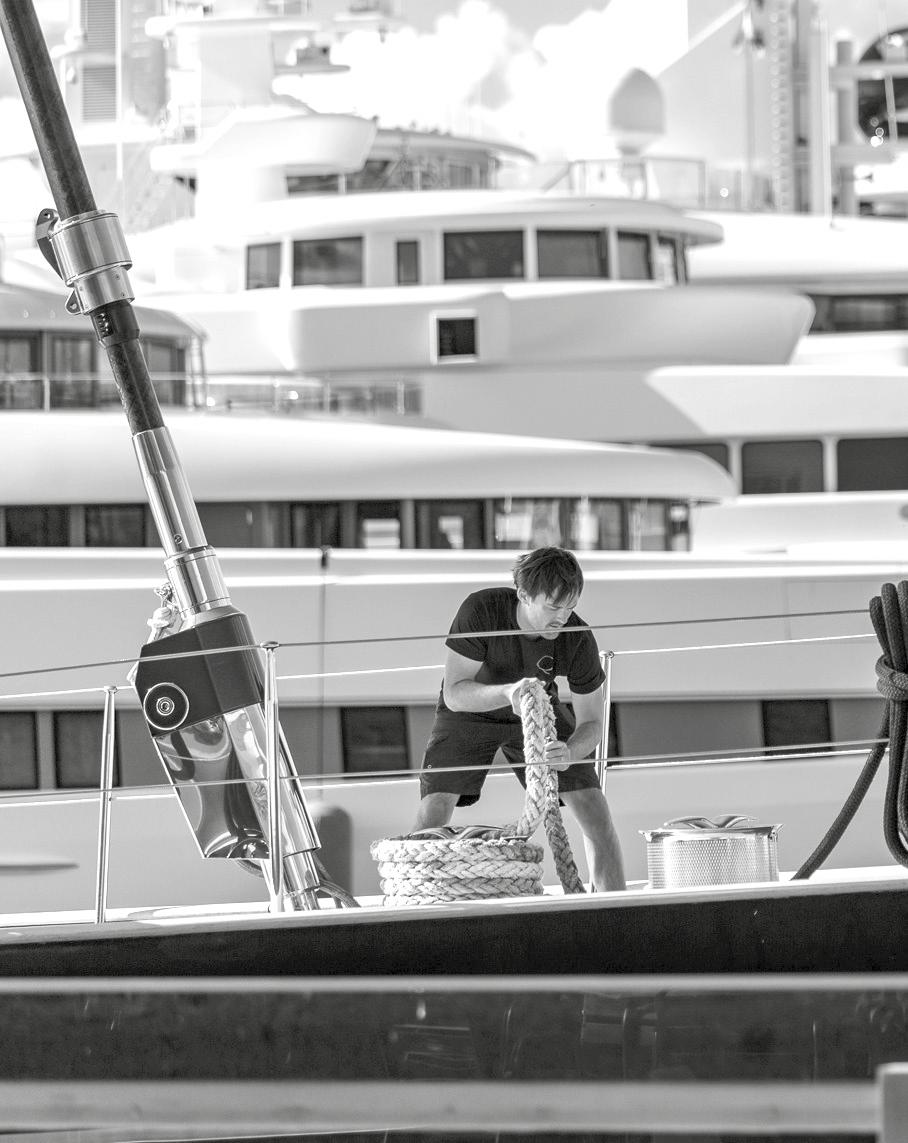

Editor-in-Chief Martin H. Redmayne explores whether an 80-metre superyacht, together with a support sister ship or shadow boat, delivers a better ownership experience than a 100-metre-plus project.
Introduction
Back in 2015, The Superyacht Agency, the consultancy division of The Superyacht Group, was tasked with a major research project on behalf of the then German shipbuilder Blohm+Voss. The brief was to investigate the perfect large superyacht that would reinvigorate this iconic shipyard and bring to the market a super platform that would meet all the ownership parameters and deliver a semicustom platform that would make money.
Unfortunately, the project was at the time when the shipyard was at a crisis point and perhaps it was already too late to save the yard from collapse. But all the work we delivered and the research and analysis were a fascinating insight into what is now becoming a new sweet-spot superyacht.
The question we now want to explore is ‘Does an 80-metre superyacht deliver a
better ownership experience, along with a support sister-ship or shadow boat, than a 100-metre-plus project?’. The following report will highlight the current market behaviour and performance and explore the key builders that are making their mark on the sector. We present a variety of concepts and opportunities that are likely to make more sense for the future when it comes to operational modes, cruising patterns, anchorages and guest service.
Following a secret tour of a recently delivered 150-metre-plus new build and various conversations with captains of 100-metre-plus superyachts, including the owner’s representative of one of the largest yachts in the fleet, I’ve often asked myself the question ‘Why build at this size?’.
These vast private palaces are meas-
ured in several thousands of GTs, with mazes of amazing interiors, exterior decks that look like running tracks at Olympic stadiums as well as garages, lazarettes and vast storage bays that house a multitude of toys, cars, bikes, dive gear, work boats, tenders and limousines – reaching more than double figures on some of these leviathans.
I remember sitting in a third-floor office in Venice at the time when another 160-metre-plus yacht was berthed alongside the commercial dock and the main deck was level with where I was seated. Two female guests were chatting, drinking tea on the exterior deck, looking miniscule and lonely on this 250-sqm-plus outdoor lounge area. Four decks below at the aft section, a group of ant-like crew were helping two tiny male guests boarding what looked like a toy Venetian tender.
So back to my question of ‘Why?’.
Only a handful of yards have been successful in the 100-metre category, with some of them experiencing financial pain and the huge risk of stepping into the sector for the first time … and as a result leaving the category to the experts.
It’s hard to ever apply logic or reason to building a yacht of this size and scale, not to mention value, but having witnessed the variety of 100-metre-plus yachts built in the past decade, perhaps the next generation may reconsider the opportunity of building such a highprofile statement asset and revert to a more intelligent size and scope of build.
Operationally, when you consider the requirements and planning for berthing, anchorages, crew numbers, refit facilities and operational costs, it’s hard to contemplate that the 0.1 per cent of the 0.1 per cent who can just about afford these gargantuan assets will, in the next few years, keep investing in such projects. This is why it’s easy to consider that a 6,000gt-plus platform of 100-metresplus could be replaced by a 2,500gt-plus 80-metre and a 700gt-plus 60-metre support yacht – with a significant amount of capital left in the private bank account.
With approximately 16 key builders and 25-plus facilities around the world that have the skills, capability, capacity and experience in the 80-metre market compared to the 100-metre sector, it makes sense for the industry to consider the optimum sizes and projects. Only a handful of yards have been successful in the 100-metre category, with some of them experiencing financial pain and the huge risk of stepping into the sector for the first time … and as a result leaving the category to the experts.
In no particular order, the shipyard brands of Benetti, Oceanco, Lürssen, Feadship, Abeking & Rasmussen, Turquoise, Heesen, The Italian Sea Group, CRN, Freire, Nobiskrug, Fincantieri, Silver Yachts, Bilgin Yachts, Palumbo and Amels/Damen Yachting make up the lion’s share of key builders who understand this category, with new projects likely to be announced during the Monaco Yacht Show 2024.
It’s becoming clear that they are all looking very seriously at this size range for a whole host of reasons. An attractive sweet spot in the upper tier gives plenty of GT between 2,000 and 3,500, but not dominating the facility or exhausting the supply chains.
Having witnessed the success of the Amels 242 (74 metres) and the new Amels 80, with eight and four units sold respectively, and the recent Oceanco 80-metre Simply Custom concept project with an array of designers working with a proven technical and engineered platform, it’s possible the market is trying to encourage owners and their project teams to be slightly more controlled and conservative with their specifications, customisation and investment.
If you consider the origins of Oceanco and its hugely successful 80-metre Alfa Nero era, it’s possible that owners may need some further education on the value proposition of this size category and the additional value a support vessel brings; the more you look at it, the more the numbers make sense.


COMPACT AND POWERFUL THE BEST SIZE RATIO ON THE MARKET
SUPER FAST SPOOL UP READY TO USE
ABSOLUTELY SILENT ENJOY THE SEA
LOW MAINTENANCE REDUCED COST OF OWNERSHIP
MC 2 Quick Gyro X75 is super compact and the most powerful stabilizer of the range. It is 30% smaller than market standards, power being equal. It takes just 30 minutes to stabilize 90’ boats. Multiple installations ensure the stabilization of boats up to 400 tons. Exceptionally water-cooled to enjoy every positive result achieved.
Research and analysis
The accompanying data is a snapshot of how the market has evolved (excluding support vessels) and evidence of who the key players are and their delivery performance.
Figures 1 and 2 break down which shipyards have recently built yachts in the LOA categories of 75 to 90 metres and 90 metres-plus. The charts display the total number of yachts each shipyard has built during this period, as well as their output in three-year increments, providing insight into which shipyards have been more active in recent years.
Figures 3 and 4 analyse the current fleet of 75 metres-plus yachts by country
of build and shipyard, highlighting the top five shipyards and countries in terms of fleet share.
The data shows that more than 60 per cent of yachts in this size range are built in Germany or the Netherlands, and more than 80 per cent are built in the top five countries. Lürssen holds the largest share among shipyards. However, just over 46 per cent of the fleet of this size is constructed by shipyards outside the top five, reflecting a more diverse distribution, with around 60 different shipyards having built yachts of this size historically.
It is also worth noting that for yachts over 80 metres, the same five shipyards
and countries lead in both categories.
Figure 5 (overleaf) presents the annual construction of yachts of more than 75 metres and 80 metres in length, highlighting the clear upward trend in this size category since 2000. A simple linear trend line has also been added, indicating that if this trend continues, by 2030 the industry could consistently see the construction of more than 13 yachts over 75 metres and over 10 yachts over 80 metres each year.
Following this, Figure 6 illustrates the percentage of the fleet comprising yachts 80 metres or larger, showing how this proportion has grown significantly, especially since 2010.
Figure 2: Number of 90-metre-plus builds, 2015-2023
*Other: 1 each – Abu Dhabi MAR (ADM), Elefsis Shipyard, Freire Shipyard, Golden Yachts, Kusch Yachts, Lloyd Werft Bremerhaven, Nobiskrug and PT Bahtera Bahari Shipyard.
Figure 3: 75-metre-plus
Figure 4: 75-metre-plus fleet by shipbuilder
Figure 5: Yearly 75- and 80-metre-plus builds, with linear forecast
Figure 6: Percentage of the fleet that is 80 metres-plus vs 75 metres-plus




















The current concepts and projects
The following pages are designed to provide a shop window of the myriad of projects built, in build or in concept stage, in a form of compare and contrast spectrum for the 75 to 85-metre category.
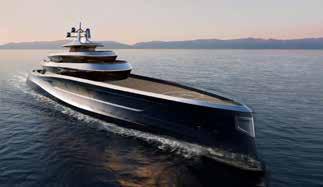
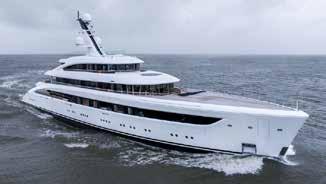
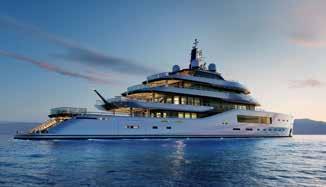
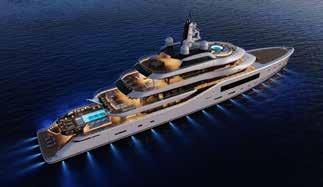
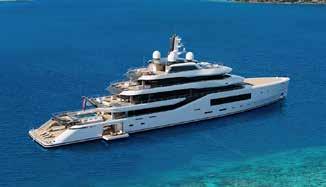
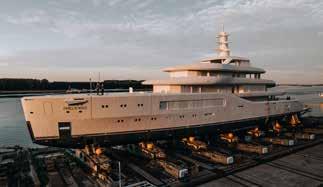

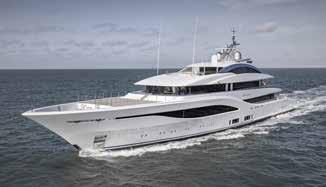


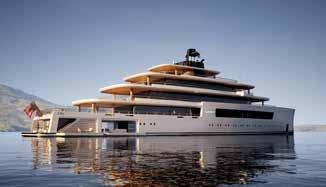
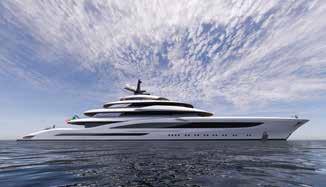
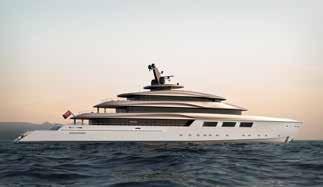
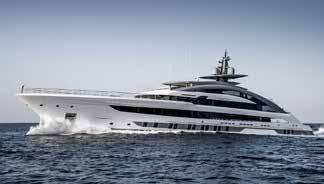
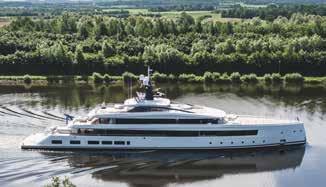

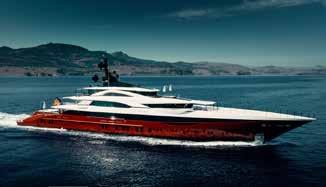
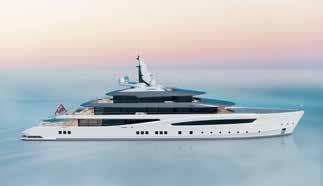
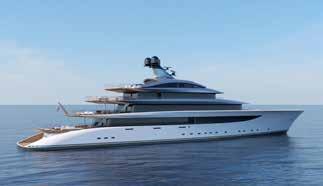



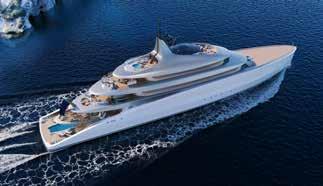
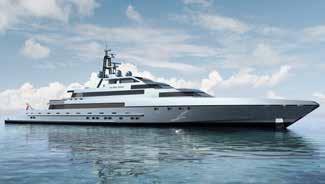
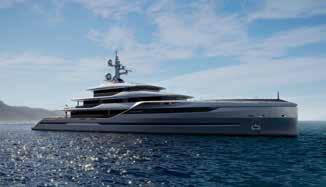



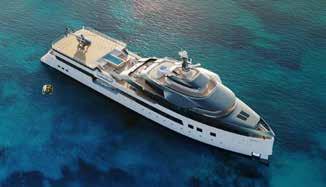
Editor's Note
The various Oceanco Concepts are part of a dynamic ‘Simply Custom’ campaign, where the yard invited a wide cross-section of the yacht designer network to create a variety of exterior and interior styles based on an optimised hull and engineering package in partnership with Lateral Naval Architects. The idea demonstrates very clearly that simplifying and managing the technical elements of the platform creates a more logical approach, with all of the exterior and interior guest elements being fully personalised to the client’s style and taste.
Your mission is unique... Your support vessel should be.

Complete your fleet with the industry’s most stable and efficient shadow series
Obviously, this is not a marketing phrase that is used very often in the market, but having discussed the current new-build pricing with a cross-section of brokers and owners’ reps, there are some incredible prices today for large tonnage new builds. Driven by energy costs, raw materials, labour costs and other factors, owners and their advisers are starting to ask more and more questions about the price and value of very large yachts. We’ve seen owners get diverted to commercial yards, large conversion projects and buying second hand because the build slots are not always available or the delivery time is beyond their expectations.
When you look closely at the 80-metre market and the number of options available, there are approximately 24 shipyards capable of building an 80-metre superyacht, with a reasonable spectrum of prices. Also, when considering the support/shadow vessel options from the current market, conversion sector and commercial yards, you can simply build
a small fleet that will deliver incredible value and also perhaps a more enjoyable operational profile.
Consider the vast amount of on-board real estate that is often taken up by all the tenders and toys on the owner’s and captain’s wishlist, and then all the operational requirements to manage and deploy this small support fleet. The vast garages and tender bays, the lifting mechanisms, large hatches and watertight compartments, the fueling stations and washdown areas all take up valuable and expensive space and are a distraction for the team on board. Add into the mix a helicopter or two and things get really interesting, from both a regulatory standpoint and a manning and fueling perspective, so perhaps the time has come to show owners the real benefits of two or more yachts.
Perhaps the added value and increased cost of the larger fleet is driven by the percentages that all the intermediaries
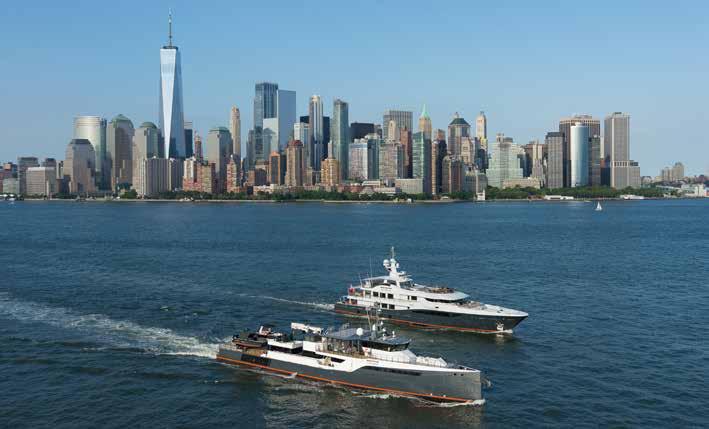
chase: the bigger the build costs, the bigger the percentage. Maybe we have to ask the client what they really want to do with the yacht and create a better explanation of the operations and logistics to make sure they get what they expect without having on-board restrictions due to half the crew getting involved in mini-fleet logistics.
Following on from tenders, toys and helicopter operations, there’s another major consideration that is often overlooked and needs careful consideration at the upper scale of these projects. A large yacht is supposed to deliver a level of service excellence that is beyond anything a customer can expect, but often, due to a lack of experience on board from designers or project teams who are just trying to maximise the guest real estate, crew service and operations play second fiddle. How many times does a captain and his senior crew join a large – or in fact any – new build and ask where the service pantry is, or the bonded wine cellar, or crew uniform and laundry store?
We often hear that space is at a premium and guest accommodation takes priority, but perhaps guest service and operations needs to be given more attention these days to ensure the yacht works well and the crew have access and capacity to do their jobs properly. Having spoken to a captain recently involved in building an 80-metre, his situation was equally frustrating, where so much space was wasted or boxed away because the designer, builder and subcontractors just wanted nice simple installations, ignoring the couple of metres of space behind the structure.
Add into the equation the number of personnel employed to run the yacht, safely and securely. More often than not, we’re hearing of advisers and intermediaries sharing crew numbers with owners that are at minimum safe manning levels, all with the message that you can save money with fewer crew. Obviously, on paper this is correct; when it comes to keeping the crew and building a great operation on board, a reduction of two or three crew may save six figures a year but that is easily cancelled out by the recruitment costs to keep new people on board.
Yes, there are still GCC royals and highly competitive billionaires who want to build a legacy statement project, but there are signs in the market that some of these projects are perhaps just a little too big and maybe even too expensive.
So let’s consider the 80-metre and a 60 to 70-metre shadow boat: more crew space, more balanced operations, more equipment space, more gear storage, better toy management and, more importantly, much more flexibility when it comes to anchorages, cruising grounds, shipyard slots for maintenance and repair, more berths and better general use and logistics.
An expert’s perspective on efficiency and cost-effectiveness
Jennifer Johnston Smith, director of business development, SHADOWCAT, says that when considering the overall investment, the efficiency of a support vessel paired with an 80-metre superyacht is unparalleled. In simple numbers, an 80-metre primary vessel and a 60-metre support vessel are in many cases less of an investment than a 100-metre-plus vessel with similar function. There’s a compelling case that the symbiotic approach is not only more cost-effective in the execution of the build, it’s also operationally superior.
A catamaran-based support vessel is not only significantly less expensive to build per gross tonnage, but also offers better fuel-efficiency and operational versatility, allowing owners to get more for their money. There will still be clients who want the biggest vessels on the water, but there is real promise in the cost benefit analysis of a fleet of two, both in the short and long term.
Johnston Smith says that one of the biggest advantages of having a dedicated support vessel is the ability to optimise the primary yacht’s space for guest enjoyment rather than storage and operations. By relocating toys, tenders and even helicopters to a support vessel, the main yacht remains uncluttered and fully dedicated to the comfort and experience of the owner and their guests. The support vessel also enhances operational flexibility, allowing the main yacht to access more secluded anchorages while the support vessel handles the heavy lifting in terms of logistics and storage.
… on crew efficiency and service excellence
She goes on to explain that a support vessel doesn’t just carry equipment, it carries potential. By splitting the operational demands across two vessels, the main yacht’s crew can focus entirely on delivering the highest level of service without being bogged down by the logistical challenges that come with managing a single super-sized yacht. This approach ensures that service excellence is maintained and the crew can operate at their best, enhancing the overall guest experience.
Something as simple as being able to circulate crew within their rotation to lighter duty or rest periods can do much to
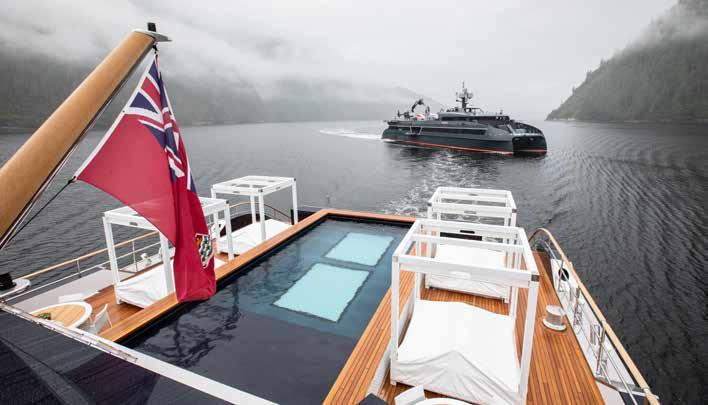
avoid fatigue and support a healthy work environment. This inevitably leads to better crew retention and the opportunity to recruit superior candidates.
The sensible choice for modern yachting
“In today’s market, the idea of owning an 80-metre superyacht accompanied by a 50 to 70-metre support vessel isn’t just a luxury, it’s a smart strategic choice,” says Johnston Smith. “You get all the benefits of a larger yacht with none of the drawbacks, such as restricted cruising areas or limited shipyard availability. With the right support vessel, you essentially create a small fleet that can operate more efficiently, provide better service and offer greater flexibility, making it an ideal solution for discerning yacht owners.”
The myths of owning a pair of vessels
There’s a common misconception that owning a pair of vessels – a primary yacht and a support vessel – compromises autonomy and complicates operations. In reality, this couldn’t be further from
the truth. Modern twinned vessel programmes are designed to enhance, not hinder, the owner’s experience. A support vessel like those developed by SHADOWCAT or Damen Yachting offers incredible flexibility, allowing the main yacht to remain uncluttered and focused on providing the ultimate in luxury and service while the support vessel handles logistics, storage and auxiliary functions.
Another misconception is that there’s limited demand for chartering or reselling these special-purpose vessels. However, the market has shown quite the opposite. The few support vessels that do become available are met with brisk and competitive interest, thanks to the operational advantages and enhanced guest experiences they offer. These vessels are often seen as highly desirable additions to a yacht fleet due to the utility and enhanced flexibility they bring.
Johnston Smith notes: “We’ve observed a trend in recent significant launches where marine programmes are adopting a twinned vessel approach as they move closer to operational readiness or very
shortly after delivery of a mothership is taken. This shift underscores the growing recognition of the value that a paired yacht and support vessel bring to an owner’s programme. By starting these conversations during the design, build or purchase phase, we can ensure that the interface between the primary yacht and the support vessel is seamless and optimised for the owner’s needs from day one.”
Integral to any marine programme “From our experience, the feedback from clients who have integrated a support vessel into their programme has been overwhelmingly positive,” concludes Johnston Smith “Once owners and their crews experience the enhanced operational efficiency, expanded capabilities and the overall improvement in guest experience that a support vessel brings, they often tell us they could never imagine returning to a single-vessel scenario. The support vessel becomes integral to their operations, offering a level of flexibility and service that simply isn’t achievable with a standalone superyacht.”
The numbers make sense At the top end of the market, there seems to be a common statement that prices have increased dramatically and this is just what it costs to build these days. However, the caveat is how long will clients absorb this increase and how many are willing to spend €250 million to €300 million and much more on these leviathans.
There are obvious triggers to ensure clients keep going bigger, and that there is more interior volume and deck space to allow designers to invest millions into the living quarters. A bigger overall budget allows all interested parties to access their intermediary fees and everyone involved in the team likes to have the status of being part of a media-frenzied major landmark project. But will it continue and does it still make sense? I’m just not sure. Yes, there are still GCC royals and highly competitive billionaires who want to build a legacy statement project, but there are signs in the market that some of these projects are perhaps just a little too big and maybe even too expensive. With prices per GT ranging from €50,000 to €100,000-plus for the current


range of 80-metre builders, investing in a large 100-metre-plus yacht is a serious investment. But is it always a smart one? A 79.9-metre (80-metre) project, with a support or shadow yacht of 50 to 70 metres, with volumes of 2,000 to 2,999gt and 700gt respectively will deliver a very interesting operational package with a price point of approximately €200 million.
It’s apparent that captains like the concept, crew like the concept and owners – when they have experienced the fleet concept – understand the value proposition. But perhaps we need to start helping owners understand and appreciate what this really delivers: a huge cash lump sum retained for other investments, a significant yacht that delivers everything you need when enjoying time on board, a great charter platform, lots more flexibility in terms of locations, marina berths and anchorages, and a yacht that’s designed for service and experience with a support/ shadow yacht designed for efficient operations and logistics.
We have to dispel the myths and misunderstandings, we have to present
the facts and figures and we have to build projects that really make sense for all concerned, on proven platforms within the right regulatory parameters, and that may be more sellable on the second-hand market if one should choose to buy new again.
Our sources tell us that Lawrence Stroll sold his previous 96m-plus M/Y Faith to another F1 billionaire and will soon be taking delivery of his 79.9-metre new Faith for all the reasons we’ve highlighted above: reduced compliance complexity, reduced costs of operation, more operational flexibility and no pilots or anchoring permissions required in certain locations.
A captain currently taking delivery of another 79.9-metre new build who is battling with various parties to fit everything in the current project is working on the owner to consider a support yacht to mitigate all the spatial pressures. And based on the recent success of the Amels 242 (eight units sold) and the new Amels 80 (79.9 metres, four units sold and the
first one being delivered in spring 2025), this is a very interesting market sector. Oceanco’s new Simply Custom strategy is again a validation of this sweet spot that has made it the shipyard it is today.
Similarly, the new Lürssen M/Y Haven and the recent Feadships M/Y Sakura and M/Y Obsidian, combined with all of the yacht profiles we’ve presented in this report, demonstrate that this isn’t just an operational and financial sweet spot, but also that most of these projects look great and have what’s called a balanced and beautiful profile.
Size used to matter; now perhaps it’s a different market, where the right blend of comfort, efficiency, flexibility and operational support will actually deliver what owners and their guests are looking for but in a more balanced profile.
I wrote an article about ten years ago, extolling the virtues of two for the price of one, referring to yacht-support platforms and the research we did for the then Blohm+Voss new-build team about the BV 80. These have all aligned, and seem to be the really smart and logical approach to the upper tier of yacht ownership. MHR
All analysis was undertaken by our data and research consultants. We provide bespoke consultancy projects that help clients make informed, data-driven decisions. Scan the QR Code to see examples of our work.
In the industry of luxury superyacht construction, the demand for large glass surfaces has skyrocketed. As owners and designers push the boundaries of design to create seamless connections between the interior and the ocean, the challenges of glass installation have become increasingly complex. At the forefront of addressing these challenges is TILSE, a German-based glass manufacturer known for its high-quality yacht glazing solutions. With a legacy of over 300 superyacht projects, TILSE’s expertise has been crucial in overcoming the technical hurdles associated with modern yacht glass installation.
The growing complexity of glass installation
Gone are the days when glass installation on yachts was a straightforward task. Today’s superyachts feature floor-toceiling windows, complex curves and expansive glass panels that require accurate planning and precision. As Henning von der Thüsen, Managing Director of TILSE, explains, “The average glass surface per metre length is constantly increasing. Clients now demand roomheight glass to create an uninterrupted view of the sea, posing significant engineering and logistical challenges.”
One of the primary challenges is the sheer size and weight of the glass panels. Compound safety glass is not only heavy but also requires precise handling to ensure that it fits seamlessly into
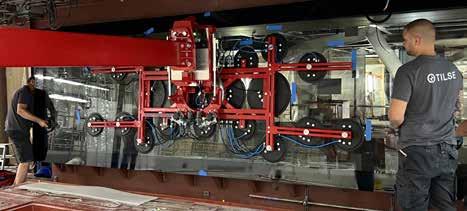
the yacht’s structure. For the complex installation, scaffolding often has to be dismantled and the construction process of the yacht has to be planned around the final installation of the glass panes.
Innovative solutions for complex installations
To address these challenges, TILSE has developed specialised equipment that enable the precise installation of large glass panels. One of the standout innovations is the so-called ‘Monster’, a device designed specifically for handling and installing massive glass panes. The ‘Monster’ allows TILSE’s team to position the glass with millimetre precision, ensuring a perfect fit and the highest quality finish, even in hard-to-reach areas.
This specialised equipment is just one aspect of the complex installation
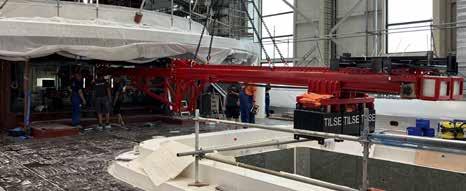
process. “The process and installation effort are invisible to the end customer,” says von der Thüsen, “but it requires a great deal of experience and coordination between the manufacturer and the shipyard.” TILSE’s years of experience and close collaboration with shipyards have been instrumental in overcoming the challenges associated with modern yacht glass installation.
The importance of early involvement
Given the complexities involved, TILSE emphasises the importance of early involvement in the yacht design and building process. “It is a serious situation to be asked to provide a complex glass solution once the superstructure is complete,” notes von der Thüsen. By being involved early, TILSE can advise on the feasibility of certain designs and suggest alternatives that achieve the desired aesthetic without compromising on safety or quality and ensure that the final glass installation will be successful. TILSE’s proactive approach has helped prevent costly last-minute changes and ensures that the final product meets the highest standards. As von der Thüsen points out, “We are always available for designers, builders or clients to contact us with questions. If they consult with us early on, we can explain the physical limitations of glass as well as the requirements for a successful installation on board.”
by Richard Orme
Richard Orme, founder of The Superyacht Mentor, explains why reputation matters … and that the responsibility for this starts at the very top.
Reputation can’t be delegated. Successful people know this and, by default, most yacht owners do too. So when it comes to yacht ownership, what can owners do to ensure that the stewardship of creating and nurturing their yacht’s reputation is not left unchecked, and why is this so important?
Irrespective of a yacht’s size, value or the salary levels offered, reputation matters when it comes to enjoying your yacht ownership.
For decades, yachts, and their beneficial owners and leadership teams, have been known among established crew as either a ‘good’ or a ‘bad’ boat to work on, and like any thriving business with its success deeply rooted in its stakeholders’ ability to maintain a reputation that attracts the best talent, yachts are no different.
But here’s the twist. A successful company only needs to attract the best talent against a limited competition pool that, in most part, is confined
by geographical limits. However, the competition in yachting is vast and on a like-for-like basis. It’s similar to having 5,000 identical businesses, all located in the same street, offering the same salaries and benefits.
That’s why a yacht’s reputation matters and is the main contributing factor to how much an owner will enjoy their vessel because enjoyment is directly related to a yacht’s crew, and reputation is directly related to the choice of crew.
So what defines a yacht’s reputation when compared to another when it comes to attracting and keeping the best talent? Culture. Not just any culture but a value-driven culture that nurtures all the behaviours of everyone involved from top to bottom, on-board and ashore, to create an environment where crew can thrive. And when your crew is thriving, your yacht’s reputation becomes the measure of its high performance.
Culture is often defined as a way people
behave without rules to govern them. Of course, there are many rules and regulations, procedures and policies needed on board for a yacht to operate, but it’s a consistent valuedriven culture that binds everyone, especially with a rotating crew (that creates different leadership styles) and with management from shore-based leadership teams.
So who is responsible for nurturing a yacht’s culture?
The short and only answer is the ultimate beneficial owner. Without their engagement to define a yacht’s values to drive and nurture a positive culture on board, all the crew-leadership training in the world will have little impact on improving a yacht’s reputation. The ultimate beneficial owner can’t delegate this task. It has to come from the very top, bypassing any corporate veil or family officer, so the ultimate beneficial owner’s values become the foundation of the crew’s and shore-based team’s behaviours that they actively recognise and reward.
An owner who wants to lower their crew turnover, while at the same time save significant costs incurred with high attrition rates, must take ownership of their yacht’s culture so that its reputation can look after itself.

Much like the role of a CEO in a successful business who is tasked to lead a team of people by a valuedriven culture to create an environment where all efforts are aligned to achieve a company’s purpose and ‘profit generation’, leadership in yachting is no different, albeit that a yacht’s purpose will be rather a ‘pleasure generation’.
And whether an owner’s pleasure is defined by the pursuit of adventure, the creation of amazing memories or the experience of private luxury travel, pleasure is unquestionably the purpose of any yacht – and therefore the goal of the yacht’s leadership team to achieve.
Therefore, who in a yacht’s leadership structure should fulfil the equivalent role of a CEO and who is ultimately responsible for ensuring that the purpose of an owner’s yacht ownership is met? A captain, of course, is often tasked to fulfil the latter, but when done so in isolation and without a defined set of ultimate beneficial owner’s values, this can leave a yacht’s entire leadership direction
open to interpretation and sometimes manipulation.
An owner who wants to lower their crew turnover, while at the same time save significant costs incurred with high attrition rates, must take ownership of their yacht’s culture so that its reputation can look after itself.
Like reputation, values can’t be delegated, but creating a yacht’s culture can be actioned by others on your behalf through an ‘owner’s pact’ which should provide a clear pledge from the ultimate beneficial owner on the importance of culture, communication and compassion, and include as a minimum:
• Clear values
• Clear open communication policy
• Clear exit interviews held without fear of judgement or reference leverage
• Clear commitment to compassionate leadership
If your ownership isn’t as pleasurable as you would like or had hoped, then
question your yacht’s reputation, and task your team to measure reputation as a high-performance indicator.
There is a choice coming to the fore for owners: to continue as they have done, battling high crew turnovers fed by toxic work environments, or commit to changing the culture of yachting which, if adopted and embraced by those owners who recognise the power of a value-driven culture, will elevate their yacht’s reputation from the competition to attract the best crew – crew who will vote with their feet by avoiding those yachts that don’t display an owner’s pact and going to those that do.
There is much narrative in yachting about the opulence of custom – having things exactly the way you want them, which quite rightly has been at the heart of the industry’s founding principles since the beginning. Now is the time for owners to understand that not investing in custom culture will only steer the experience of superyacht ownership to that of a luxury cruise. RO
Let’s preserve what inspired our passion

Discover our solutions to drive sustainability and improve value REFIT FOR THE FUTURE!

The new Pastrovich X-PAGODA is one of the first yacht builder/charter ownership projects that is affordable, low-impact, super-efficient and taps into a potential market that our industry has often struggled to attract.

BY MARTIN H. REDMAYNE
It’s a big conundrum and one that I’ve often considered at length: yacht ownership is expensive and sometimes frustrating with all of the unknowns and complexities. While hundreds of buyers and owners still love the process of buying, building, owning and selling their various floating assets, many different projects have been discussed and presented to the market that make sense for the future. With chartering, renting and using part of a yacht currently enjoying a resurgence of interest, and cruise companies and luxury resort brands label0ling their latest boutique ventures as superyachts, it’s becoming an interesting time.
Having worked on a recent business model for a multi-fleet programme of identical yachts, all for charter and accessible to a private network of members and fractional owners, it has become a bit of a pet subject and one where the numbers really do add up. It’s often been said that no one makes money out of owning a yacht but, over the years, those owners who have run small fleets, like De Zille or Liveras, have delivered some exceptional programmes with a tangible return.
So when a new concept/business proposition was shared with me, via old friend and creative visionary Stefano Pastrovich, I felt the hairs on the back of my neck rise with excitement. I’ve always appreciated his creative genius and unique thinking, but this time our stars had aligned and we both agreed that ‘charter is the future’.
When considering the number of UHNWIs, where the ‘U’ stands for ultra, the wealth category includes those whose status is US$30 million, and therefore not really in the owning category, we end up with a staggering 630,000 individuals globally, according to all recent wealth reports. Let’s call it the world’s one per cent club. According to our estimates, we have a superyacht market that is driven by an owner network in the one per cent club that equates to about 0.5 per cent of that club, leaving more than 625,000 UHNWIs each with US$30 million or more to invest and potentially enjoy yachting … if it makes sense to them.
When considering the sheer number of ultrawealthy individuals and trying to deliver access to something that suddenly starts to make economic sense, we may end up with a market shift that mimics the evolution of the private aviation sector, where use and access drove membership programmes and clubs to reduce the amount of capital tied up in an asset that wasn’t making money.
Returning to Stefano Pastrovich and his new project, having been in this market for more than 37 years, I’ve seen a lot of projects, concepts and ideas.
Some have been stupid, some unbuildable, some that will never float and many that are just copies of someone else’s idea. However, I think Stefano is both consistently original and creatively brave and his new X-PAGODA project breaks the mould by being a truly smart design but with a business model attached, something incredibly rare in the world of yacht design.
Over the past decade we have seen cruise companies launch projects and compare them to the superyacht category, suggesting there’s a link or synergy with our market but, in my opinion, this is nonsense. A 150-metre ship with 60 pax capacity or more has no place in the superyacht market because the customer demand and use is so different. It is purely a new market that serves the first-class passenger who wants to escape the masses on board the 400-metre, 2,000 pax ship.
However, the X-PAGODA triggers something exciting and taps into a potential market that our industry has often struggled to attract: the several hundred thousand UHNWIs who recognise that owning a yacht requires patience, stamina and more money than you originally planned to spend and therefore choose not to.
Consider a fleet of 59-metre superyachts that are each designed to accommodate 10 couples in a series of 25 square-metre suites, all with five-squaremetre balconies on the main deck, located in the most exclusive and exciting cruising grounds on
What is exciting is the naval architecture and engineering, built in a modular programme along the lines of cruise-ship construction, across a wide-bodied catamaran hull, to deliver a stable platform at anchor, huge interior volume and highly efficient performance for relocation from anchorage to anchorage.
The great wealth transfer will super-charge existing trends
Over the next 20 years, a massive transfer of wealth and assets will occur as the silent generation and baby boomers hand over the reins to millennials. This shift will see US$90 trillion of assets move between generations in the US alone, making affluent millennials the richest generation in history. The transfer is happening amid seismic changes in how wealth is put to use. The difference in outlook between younger and older generations will result in a substantial reappraisal of marketing strategies for anyone wanting to sell products or services to this newly wealthy group.
Wealth is becoming more diverse it may be starting from a low base, but the trend is undeniable. Recent survey findings from Altrata suggest women make up around 11 per cent of global UHNWIs. While still not a large share, this represents rapid growth from just eight per cent less than one decade ago.
Gen Z is the most confident in their ability to create wealth
Knight Frank’s Attitudes Survey reveals that 71 per cent of UHNWIs globally anticipate growth in their wealth this year. For HNWIs, Knight Frank’s Next Generation Survey reveals a more conservative figure of 65 per cent. A clear pattern emerges when data is analysed by age: younger affluent groups are more confident about the economic outlook compared with older groups. Only 52 per cent of HNWI boomers anticipate growing their wealth in the next 12 months in contrast to 75 per cent of Gen Z-ers, with 43 per cent expecting ‘significant growth’. Male HNWIs express greater confidence than women. This is particularly pronounced among male millennials, with 75 per cent expecting their wealth to grow, compared with 64 per cent of women. However, for Gen Z, these expectations are entirely reversed, with a remarkable 81 per cent of women in this group expecting growth. Half expect ‘significant growth’.
Environmental concerns will influence investment decisions
Climate change is an area where Knight Frank’s results show clear generational differences in priorities. Millennials appear to have got the message when it comes to cutting consumption – 80 per cent of male and 79 per cent of female respondents say they are trying to shrink their carbon footprints. Male boomers take a different view, with just 59 per cent trying to reduce their impact, well below their female peers (67 per cent). Recent work undertaken by The Future Laboratory confirms a shift in attitudes around wealth, with younger groups looking at the opportunity it provides to act as a force for change.
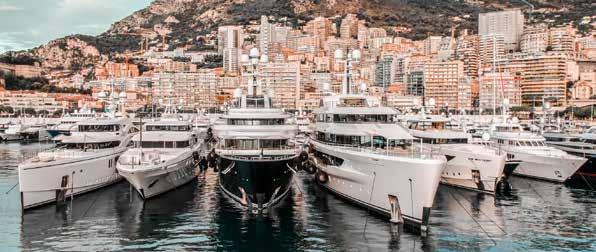


I formed the X-PAGODA team based on my life philosophy: to realise great ideas, it is essential to assemble a group of professionals eager to develop and innovate in total economic and intellectual freedom. The partners of X-PAGODA are driven by strong motivation, determination and curiosity to be part of this adventure which, devoid of certainties, is perceived as grand and achievable.
STEFANO PASTROVICH
TECHNICAL DESIGN PARTNER
Exterior/interior design technical office
GMARTINESDESIGN
Arch. Giuseppe Martines
Naval architect
CHARTWELL MARINE
VISUALISATION PARTNER
Video & rendering WOLF

It’s one of the first yacht builder/charter ownership projects that delivers a platform that creates what Pastrovich has labelled ‘democratic luxury’.
the planet. This is a fleet of identical superyachts, built to maximise efficiency in terms of build and operation, perhaps as many as 10 or more. I’d hate to describe them as floating boutique hotels; perhaps an exclusive villa that you share with a group of friends or a corporate retreat is a better description.
What is exciting is the naval architecture and engineering, built in a modular programme along the lines of cruise-ship construction, across a widebodied catamaran hull, to deliver a stable platform at anchor, huge interior volume and highly efficient performance for relocation from anchorage to anchorage. But, more importantly, due to the concept of a global fleet, all in unique locations, the need for long passages from ocean to ocean is mitigated, so performance and range can be optimised.
Apart from projects I’ve worked on with investors and other entrepreneurs who have conceived the idea of fleet models and opening up access to superyachts to a wider customer base, with revenue models and EBITDA written into the project business model, the X-PAGODA really does tick a lot of financial boxes and bring a level of disruption and dynamics that will create a wave of interest.
There’s so much more to write about this project and while I look more closely at the business model and the concept, it’s better to share just enough, so owners and charter clients or investors and resort operators want to know more. The CAPEX and OPEX equations of the X-PAGODA EBITDA, combined with 300 days of operational occupancy, are enticing. Building commercially at €25,000 per gt, and then optimising the cruising pattern by the relocation efficiency, starts to make investing in yachting an exciting prospect.
Admittedly, it does have similar features to jet programme offerings – and this is something Pastrovich is passionate about as both a pilot and designer – but it’s one of the first yacht builder/ charter ownership projects that delivers a platform that creates what Pastrovich has labelled ‘democratic luxury’: affordable, low-impact, super-efficient, exclusive but inclusive and open to many more customers than any other superyacht charter I’ve ever seen. More importantly, it offers something that is quite alien to our sector: a yacht-building and ownership investment programme that is designed to make a profit. Bravo Stefano. MHR
The benefits of choosing a combined private wealth and yacht services provider.
In the world of luxury lifestyle management, expertise and good governance are paramount. Managing the asset structure and the yacht is complex and timeconsuming for superyacht owners, but partnering with a single yacht ownership and private wealth services provider such as Praxis can transform this process. Such a relationship offers numerous benefits that streamline and enhance the ownership experience – allowing the client to focus on enjoying their yacht.
In this article, Bruce Maltwood, Praxis’ Director of Yacht Services, and James Wiseman, Managing Director of the Guernsey Private Wealth team, review the key advantages of an integrated approach. Together with the broader private wealth and yacht services global team, they provide bespoke yacht ownership structures to owners of vessels of all sizes, alongside yacht and crew management services, leveraging over five decades of company experience.
One of the most significant benefits of using a single provider for yacht ownership and private wealth services is streamlined day-to-day management. With all services coordinated through a

single point of contact, the owner reduces the time spent dealing with multiple providers. At Praxis, dedicated account directors provide tailored solutions that meet the owner’s specific needs, with a deep understanding of their preferences, lifestyle, and financial goals.
The benefits of a combined approach start at the onboarding stage, with clients required to complete only one set of due diligence. Partnering with a single provider also offers the potential for cost efficiencies provided by bundled services. Additionally, this model can reduce administrative overheads by consolidating billing and reporting processes, lowering direct costs and saving valuable time. The financial clarity of a unified service provider can allow for better budget management and financial planning.
Owning a superyacht presents unique risks and these can be mitigated by holding the asset in a corporate structure such as a trust or special purpose vehicle (SPV). Leveraging the benefits of limited liability ownership, asset segregation and professional management, owners can enjoy their yacht whilst managing their personal liability.
At Praxis, we conduct transactions and manage assets with a high level of discretion while ensuring sound governance and regulatory compliance for our clients. With unified oversight of all issues related to the yacht ownership, we can reduce the risk of non-compliance and associated penalties, including reputational damage.
This focus on protection and security is a critical concern for yacht owners not only regarding their physical assets and financial information but also in relation to privacy for themselves and their families. As a company licensed and regulated by the Guernsey Financial

Services Commission, Praxis offers a robust security framework with advanced cybersecurity protocols, data access controls and secure financial transactions.
As a regulated provider, we comply with stringent financial regulations and privacy laws that mandate rigorous data protection measures, ensuring that our clients’ personal and financial information is handled securely. Furthermore, we are legally bound by confidentiality agreements that prevent unauthorised disclosure of client information, which provides an additional layer of security. Using a single yacht ownership and private wealth services provider offers significant advantages for yacht owners. The benefits are clear, from streamlined management and cost efficiency to enhanced security, personalised service, and simplified compliance. This integrated approach streamlines the complex tasks associated with yacht ownership and wealth management and improves the overall experience, allowing owners to enjoy their luxury assets with peace of mind.
praxisgroup.com/yacht-services
After a spate of highly publicised fires, both on board yachts and in shipyards, is the industry currently doing enough to take a more proactive stance and make the necessary improvements before the next disaster forces the issue?
BY CONOR FEASEY
It’s beginning to feel a bit like Billy Joel’s 1989 smash hit We Didn’t Start the Fire. Just as the Piano Man chronicled decades of significant global moments, we, in yachting, seem to be stacking up major fire incidents with alarming frequency. Fires at sea, in construction sheds and marinas have made regular headlines. But instead of seeing these fires as a sensationalist outlet for the media, it should remind us that while we may not have (personally) started them, we’re certainly responsible for preventing the next one.
Over the past five years, a series of high-profile fires has rocked the yachting industry, both in shipyards and on board vessels, raising concerns about safety and fire-prevention measures. These incidents have caused significant damage, disrupted operations and, in some cases, resulted in the total loss of vessels.
In July 2024, a catastrophic fire at a northern European shipyard destroyed a large yacht under construction, echoing
the Project Sassi fire in 2018, with firefighters working for more than 20 hours to bring the blaze under control. A facility in Turkey also suffered a major fire in May 2023, heavily damaging a building hall. Although no yachts were lost, the fire significantly impacted operations. Similarly, an Italian yard experienced a destructive fire in the same year.
Beyond shipyards, a series of notable fires on board superyachts has further drawn attention to the growing risks.
To name but a few: In August this year, the 47-metre Atina caught fire off the coast of Sardinia, Italy. Despite the crew and passengers being safely evacuated, the yacht was completely destroyed and ultimately sank. In October 2023, 46-metre Navis One was similarly engulfed in flames near Koufonisia, Greece, while 59-metre Andiamo suffered the same fate in Sydney Harbour, Australia, after flames spread rapidly due to the large quantity of fuel on board.
Together, these fires have had a
seismic impact on the industry, intensifying scrutiny around fire-safety protocols and driving up insurance premiums. But instead of focusing on the smouldering ashes of what was, we should instead be shifting the focus towards prevention. As superyachts continue to push the limits of design and technology, the demand for improved fire-prevention measures has never been more important. The key questions now are whether these incidents are becoming more frequent and how the industry can take proactive steps to prevent such disasters in the future.
“While I am not involved in any of the recent shipyard fire events, I have, on behalf of owners, underwriters and others, dealt with fire-investigation and damage repairs necessary due to fires aboard ships and yachts,” says Dan Robsham, a hull and machinery surveyor and licensed chief engineer with a career that has spanned 42 years.
“Looking back without reference to underwriters’ statistical records, it doesn’t
seem to me that there are more shipyard fires today than has historically been the case,” adds Robsham. “Shipyards are a place where the fire triangle of fuel, oxygen and heat thrives, all in close quarters and near many sources of ignition.
“During the past 40 years, the record shows many costly fires have occurred in yacht shipyards in Europe, Australia, Asia, the Middle East and North America. And over that time, I have dealt with shipyard fires caused by hot work, temporary lighting and causes we simply could not determine.”
The reality is that fire often strikes without warning, usually due to human error. Robsham recalls visiting a shipyard in the UAE to discuss safety protocols for a large yacht arriving from Europe. To his shock, he discovered a drydocked motoryacht fully engulfed in flames, right between the office door and his car. When he contacted the yard manager to report the fire, the initial response was disbelief, but it quickly became clear that work on that yacht had abruptly come to an end.
In another case, Robsham recounts that a yacht over 50 metres in length, docked after post-sea trials, accidentally triggered the water mist sprinkler system when an unsecured access hatch struck a sprinkler head after hours. Although the system operated as intended, the resulting overnight flooding caused significant damage to the newly finished guest accommodation, leaving much of it in ruin.
Even when rigid precautions are in place, it takes only one moment of poor judgement to spark a disaster. “During one large refit, we organised best practices: joint inspections by the yard and crew before issuance of any hotwork permit, fire watches, charged fire hydrants, cleanliness and a rigorously enforced no-smoking policy. Signage was posted and access strictly controlled,” says Robsham.
“Hazards were evaluated and dealt with as they arose. All of this was well underway when one day we discovered a subcontractor had, unknown to us, been carrying out hot-work repairs inside the floating dock underneath the ship. While no disaster resulted, there was a failure to communicate on a ‘Cool Hand Luke’ scale that prompted a lot of hard feelings and sharp words.”
Times have certainly changed, as Robsham points out. Yachts today are far larger and more complex than ever before and are filled with flammable liquids, intricate hydraulic and HVAC systems, heated floors, glass walls and sprawling atriums. They’re also packed with personal electronics, petrol-powered tenders and lithium-ion-battery water toys, all crammed into every available space between the owner’s cabin and the pizza oven. It’s a hazardous environment and it’s beginning to impact the changes to code and insurance policies.
Michelle van der Merwe, superyacht account manager at Pantaenius Monaco, says, “While we’re not actively asking for detailed information about all new technology on yachts in build, except for specific cases, we’ll ask more questions to assess the risk for certain shipyards or yachts using newer technologies, especially if we know there are batterypowered toys on board.
“But as of now, we aren’t actively tracking that, though it could change in the future if these issues become more widespread. And given the number of fires this year, if battery-related causes are confirmed, we might see more regulations coming in. New clauses in insurance policies could start to appear as well.”
For Mike Wimbridge, director at Pantaenius, the rise in fire incidents across the sector is closely linked to the increasing presence of new technology, particularly on-board toys and gadgets. “Most people would agree that there’s simply more ‘stuff’ on pleasure craft now. Mobile phones, drones and various other devices,” says Wimbridge. “On superyachts, in particular, you’ve got all the toys and additional equipment.
“Many of the current safety protocols focus on following the manufacturer’s instructions. There is, however, significant media coverage of boating, especially on social media, which is much higher now. You often see grainy mobilephone footage of boats on fire. It’s becoming much more visible.”
The yacht insurance market is relatively small, and when it comes to fires at large shipyards these facilities are typically insured through the commercial marine market rather than the yacht-specific market, which is a subset of commercial marine. While a major loss may not immediately affect

Dan Robsham, hull and machinery surveyor and licensed chief engineer.
“Shipyards are a place where the ‘fire triangle’ of fuel, oxygen and heat thrives – all in close quarters and near many sources of ignition.”
yacht insurance, there’s likely to be a ripple effect. Shipyard and construction premiums are expected to rise, and this could potentially lead to a contraction in the market.
For multinational firms, insuring yachts, whether in construction or on the water, may become less appealing, particularly given the heightened focus on the industry due to high-profile disasters. In the bigger picture, some insurers might decide it’s simply not worth the risk, which would push up premiums and limit the type of coverage available. Reputational risk is also a significant factor; large marine insurers might begin to view yachts as less attractive.
“It takes a strong person to go to the board and say ‘yes, we should still write this’, especially when they’ve already faced tens of millions in claims this year,” says Wimbridge. “Sometimes, the numbers just don’t add up compared to the income they’re generating.”
Van der Merwe adds, “These instances are going to have a knock-on effect on premiums. There will likely be some tightening of conditions and maybe some insurers won’t want to cover certain types of yachts. Highervalue sailing yachts or those using new technologies, like hybrids, might be affected. It really depends on what comes out of the investigations.
“That, in turn, leads to an increase in premiums and coverage changes for people. It’s pure supply and demand. Right now, there are around 20 companies you can go to to insure a big yacht. Next year, that number might drop to 15. It might stay at 20, but with fewer willing to take on the risk.”
On a human level, the reality is that if you’ve ever bought a lithium-ionpowered tool or gadget, you probably didn’t bother reading the manual. You just plug it in and go. Imagine that same
Michelle Van der Merwe, superyacht account manager, Pantaenius Monaco.

“These instances are going to have a knock-on effect on premiums. There will likely be some tightening of conditions and maybe some insurers won’t want to cover certain types of yachts.”
scenario on a yacht, potentially in a high-pressure situation with the owner’s family on board. If a flight board or similar device stops working, the instinct might be to grab another battery or charger and plug it in without following proper safety protocols. However, when you’re putting employees or family members on these boats, it’s something that needs to be taken seriously. Unfortunately, there have been documented cases where this lack of attention to detail has led to catastrophic outcomes.
“A fire investigator I know once said that if you told any owner they had an open bucket of petrol sitting in their engine room, they’d be outraged. But, as he pointed out, a poorly maintained battery system poses a similar risk,” says Wimbridge. “In one instance, the issue was with a battery that the crew knew wasn’t charging or working properly. Instead of addressing it immediately, they just put it in a cupboard and thought, ‘We’ll deal with that after the charter season’. The correct response should have been to remove it from the yacht immediately or at least store it properly.
“I’m surprised that level of awareness isn’t more ingrained. If a young deckhand reports that a battery isn’t charging properly and is told ‘just stick it in the cupboard’, they’re unlikely to question it or act differently.”
Robsham agrees. “It is self-evident that the fire hazards have become more numerous and varied than in the past,” he says. “It is not clear to me that the level of outfitting has somehow increased construction shipyard-related fire risks in a meaningful way. However, I do believe that the risk of in-service fires has increased. This is where onboard operating procedures must meet the challenges not dealt with by physical arrangements.”
The human element plays a critical role in shaping insurance policies in the
yachting industry, often more so than the fires themselves. It’s widely known that there’s a shortage of highly skilled crewmembers and this issue extends beyond captains to the entire crew. While there are certainly many high-quality yachts, the real problems arise when less competent or underqualified crews are involved. With a rise in incidents, both on board and in shipyards, these issues are becoming increasingly noticeable, highlighting the need for improvements. The key question remains: how can we prevent these incidents in the future?
Ensuring that both shipyards and superyachts are equipped with the right tools and safety measures is just one piece of the puzzle. Equally important is investing in crew and ensuring that those entrusted with these vessels have the skills and training to be proactive and handle high-pressure situations effectively. It’s not enough for a captain to simply have the right qualifications or be liked by the owner.
Long-standing relationships between owners and captains can sometimes obscure the reality that transitioning from a smaller vessel to a much larger yacht comes with significant risks. Owners may not realise that the captain they trust may not be fully prepared for such a leap in responsibility, and that’s where the dangers lie.
Leadership and teamwork are essential during emergencies such as fires but, unfortunately, new safety regulations tend to be introduced only after a disaster strikes. This reactive approach isn’t what the industry needs; there’s now an opportunity to take a more proactive stance, implementing the necessary improvements before another serious incident forces the issue.
Robsham says, “The September 2019 fire aboard the California-based dive boat Conception that killed 34 people exemplifies where poor design, outdated regulations and loose operating practices
all played a part in a true maritime disaster. The root cause is still debated to this day. Yet it is known that the failure of the captain and crew to keep a roving fire watch resulted in needless fatalities.”
There’s also a large concern with privately owned yachts, which often operate outside the stricter safety regulations applied to commercial chartered vessels. There’s a clear split between private vessels and commercial charters where there’s a requirement for knowledge and adherence to fire-safety standards.
“Yachts need to have the same kind of regulations in place as commercial vessels do,” says Van der Merwe. “I know it’s difficult because they’re smaller, and some commercial regulations are tough to apply in terms of space and practicality. But in terms of safety standards, there should be a minimum requirement across the board.
“From a regulatory standpoint, it’s worrying. Just because it’s a private yacht doesn’t mean the standards should be lower. If fires are increasing for these reasons, surely, regulators need to step in and enforce stricter rules for private
yachts too. I feel like Flag states need to step up, especially with the way things are going.”
In terms of improving fire safety in shipyards, one could hope that owners start asking builders, designers and managers the right questions and communicate efficiently. Rather than demanding a myriad of complex, intricate amenities on the yacht and potentially dangerous toys, perhaps they should ensure they are stored correctly, checked constantly and that all crew are properly trained in fire safety and how to use the equipment once on board.
However, balancing training with financial constraints and timing is always a challenge. With crew rotations, seasonal demands and maintenance schedules, there’s rarely an ideal moment to dedicate time to it. This becomes even more difficult when the cost of sacrificing potential charter revenue is factored in. The reality is that change will have to come from the high-end level – from the builders themselves.
“It is clear to me that a significant challenge in the shipbuilding and repair environment nowadays is meaningful
“A fire investigator I know once said that if you told any owner they had an open bucket of petrol sitting in their engine room, they’d be outraged. But, as he pointed out, a poorly maintained battery system poses a similar risk,”
“People must be informed – and understand – what the fire hazards really are ... Trade supervisors and managers must step up to the task of continuous implementation of good fire safety practices.”
communication about fire hazards with everyone working aboard and around a yacht,” says Robsham. “People must be informed, and understand, what the fire hazards really are. They must know where such hazards exist and how to minimise them through their own efforts. All of this is a mighty task in today’s commercially pressured and attention-span-challenged world. Trade supervisors and managers must step up to the task of continuous implementation of good fire-safety practices.”
The growing list of incidents simply highlights the broader issue within the industry, which is the need for stricter enforcement of safety protocols and more comprehensive training. It’s not enough to rely on regulations that may be outdated; the industry must take an active role in preventing similar tragedies through constant vigilance and adapting to modern safety standards.
There are plenty of valuable resources available to enhance fire-safety measures too. In the US, the National Fire Protection Association (NFPA), known for its expertise in electrical codes, has developed NFPA 312, which specifically addresses fire protection for vessels during construction, conversions, repairs and lay-up. In addition, the NFPA has issued more than a dozen other standards relevant to maritime operations and facilities.
The US Code of Federal Regulations
also has a section dedicated to shipyard fire safety under 29 CFR 1915. These long-standing regulations emphasise the importance of communication and firehazard awareness among all personnel on site. Similar standards, based on the same principles, are widely adopted internationally.
Furthermore, SOLAS Chapter II-2 Regulation 17 issues guidelines approving alternative fire-safety measures. As yachts continue to evolve in design and technology, this regulation is likely to play an increasingly crucial role in maintaining safety standards.
“But let it be said – common sense is just as important as any rulebook,” concludes Robsham. “On active vessels, the most common source of fires I have encountered is a pressurised oil or fuel leak, followed by lighting. My surveyor colleagues have in recent years dealt with numerous battery and electrical fires that occurred aboard active vessels.
“At this stage of my career, I am amazed at the ingenuity and innovation that exist in our industry. However, we all must remain mindful of the simplest and oldest of things when it comes to safety. Accidents happen through an unfortunate combination of factors, which if they were not aligned just so would have caused no harm. It is everyone’s daily task to keep those hazards to a minimum.”
So while yachting has seen incredible
advancements in technology and design over the past decade, with this progress comes a heightened level of responsibility. Fires, whether at sea or in shipyards, continue to remind us of the fragility of life and the industry we work in. With more frequent incidents, insurers are tightening their policies, increasing premiums and reassessing their willingness to cover high-risk vessels.
For yacht owners and builders, it’s not just about complying with regulations, it’s about ensuring that every safeguard is in place to protect their investment and keep insurance coverage viable. As the industry faces increased scrutiny, insurers will play a pivotal role in shaping future safety standards.
The lesson should be clear: safety protocols, fire prevention and proper crew training must be held to the highest standards, with no room for complacency. While it’s easy to focus on innovation, we must also prioritise the fundamental aspects of safety. The industry’s proactive response, before the next disaster strikes, will be what defines its future.
By strengthening communication, enforcing tighter regulations and ensuring everyone on board understands their role in fire prevention we can avoid becoming part of another list of tragic incidents. The fires of yesterday should drive the safeguards of tomorrow. CF





Everything you love about Awlcraft 2000, including tried and trusted application characteristics and repairability, but now enhanced with our next generation color platform. Awlcraft 3000 gives you deeper, more vibrant colors and a long lasting, high gloss finish to turn heads. GET


































































































































































































































































































































































































































by Adina Bates and Nicolas Feit


The global fleet of superyachts in operation has consistently expanded. There are encouraging signs for sustainable development and evolution of our industry, fuelled by the exponentially growing number of UHNWIs in the world. The yachting world is a wonderful laboratory for change, innovation and promotion of craftmanship.
With about 3,700 owners for the 5,500plus yachts in operation, many of the owners have more than one vessel and they are often repeat owners. The market is therefore made up, to a lesser part, of new buyers.
But that said, we can question why many UHNWIs with the capacity to build or buy yachts are simply not tempted by the allure of adventure on the seas. Environmental/climate-change concerns, perceived image or reputation linked to owning such assets in some parts of the world, little knowledge of the industry and of the innovation effort that lies behind it are some of the explanations.
A more pragmatic reason that is often repeated is that a yacht is not seen as a traditional investment. Buyers are either passionate about the sea, the maritime ecosystem and accept the associated cost thereof, or it needs to be demonstrated to them that there are possibilities to efficiently structure their yachting experience. With a low use rate by the owner or their family, and high maintenance costs, astute entrepreneurs are keen to explore all possibilities to lessen the costs, including the cost of depreciation. New ownership models are being explored to address some of the reasons for this hesitation, such as fractional ownership among others.
Another possibility to optimise the cost is to structure the funding of the acquisition in such a way that part of the equity, initially budgeted towards the transaction, is invested in valuecreating projects instead. Borrowing is used as a cash-flow-optimisation tool. Yacht loans are generally guaranteed part by a marine mortgage and
part by financial assets. The latter are invested according to a strategy agreed between the client and the bank, according to the risk appetite of the client and general market conditions.
Under this structure, the bank can finance up to 100 per cent of the fair market value of a yacht, with a major portion of the loan secured against the asset itself. Repayment is scheduled quarterly or annually in arrears and includes a balloon payment at the loan term. The mechanism allows the borrower to adjust the timing of repayments to match their future cash events. The overall financial position of the client remains more liquid over time and part of the cost of the loan is covered by the return on the invested portfolio. As a result, more than half of the market value of the yacht can be reallocated by the client to their own projects, which usually generate returns in excess of the marginal loan cost.
Guest Column
by Adina Bates and Nicolas Feit
For clients who are not risk averse, the investment team can also structure investment portfolios that can ‘beat’ the cost of credit, but that depends very much on client sensitivity.
Another example of using the same mechanism of leverage against yachts is equity release for owners who have not financed when taking ownership. It may be that circumstances have been such that they have an investment project that is not traditionally financed through standard lending, such as emerging markets investments or purchasing property in locations that are not eligible for finance. Often borrowers compare the cost of lending against yachts to the cost of lending for real estate in prime locations.
There is certainly a premium as yacht finance is capital-consuming for banks due to strict banking regulations. Yet the cost remains very reasonable when compared to the cost of financing less conventional opportunities. These are traditionally funded through private lending or private equity funds, where the expected return from the funding partner is significantly higher. In such conditions, clients find it more interesting to leverage a private asset such as the yacht instead, in order to fund these transactions.
Now, looking at the investment component, a frequent element of reluctance for clients regarding the structures typically offered by private banks is not obtaining dry financing, where the bank only takes the mortgage on the vessel as guarantee and limits their loan exposure. In this
scenario, the bank structures the yacht credit part against a classic maritime mortgage, and part as a ‘back-to-back’ loan, secured by deposits or a portfolio invested with the bank.
The mortgage part is mainly dependent according to the value of the vessel and constitutes the major part of the credit. Very often, buyers will consider the second component as a constraint imposed by the bank, whereas naturally they would prefer not to finance this portion and bring the equity in the transaction as down-payment.
While there may be other commercial factors for structuring the lending in this manner, it remains a point for review and discussion during the process. That said, even from the client’s perspective, increasing the down-payment to the seller instead of increasing the financing against the invested portfolio is not necessarily a good calculation. Any cash contribution will undergo a mechanical depreciation with the decrease in value of the yacht over time, between 3 and 5 per cent on average, depending on the age and brand of the asset. Whereas the invested portfolio can, especially in the current interest rate context, pay a fixed return over periods of up to five years.
These returns, on fairly secure products, partially offset the cost of credit at set-
up. The cost differential, which is around 1.5 per cent to 2 per cent today, can be compensated over time in a context where the indexes such as the threemonth or six-month Euribor that are used to calculate the cost of interest are decreasing. For clients who are not risk averse, the investment team can also structure investment portfolios that can ‘beat’ the cost of credit, but that depends very much on client sensitivity. The bank is very careful to correctly qualify and inform the clients of the risks of the various investment and lending strategies so they feel secure in respect to their position.
At Société Générale Private Banking Monaco, our aim is to develop a wider, individual wealth management relationship with the client. The purpose is to build trust and preserve wealth through a long-term reciprocal relationship. The loan mechanism, the investments we agree upon with our clients and the overall strategy reflect this objective.
Our aim as an individual-focused lender is to secure the client’s position during the whole life of the relationship. We have a responsibility to build a solution that is not only very competitive at set-up, but one that is sustainable over time. The solutions that we can propose are therefore tailored to address both of these requirements. AB & NF



































































































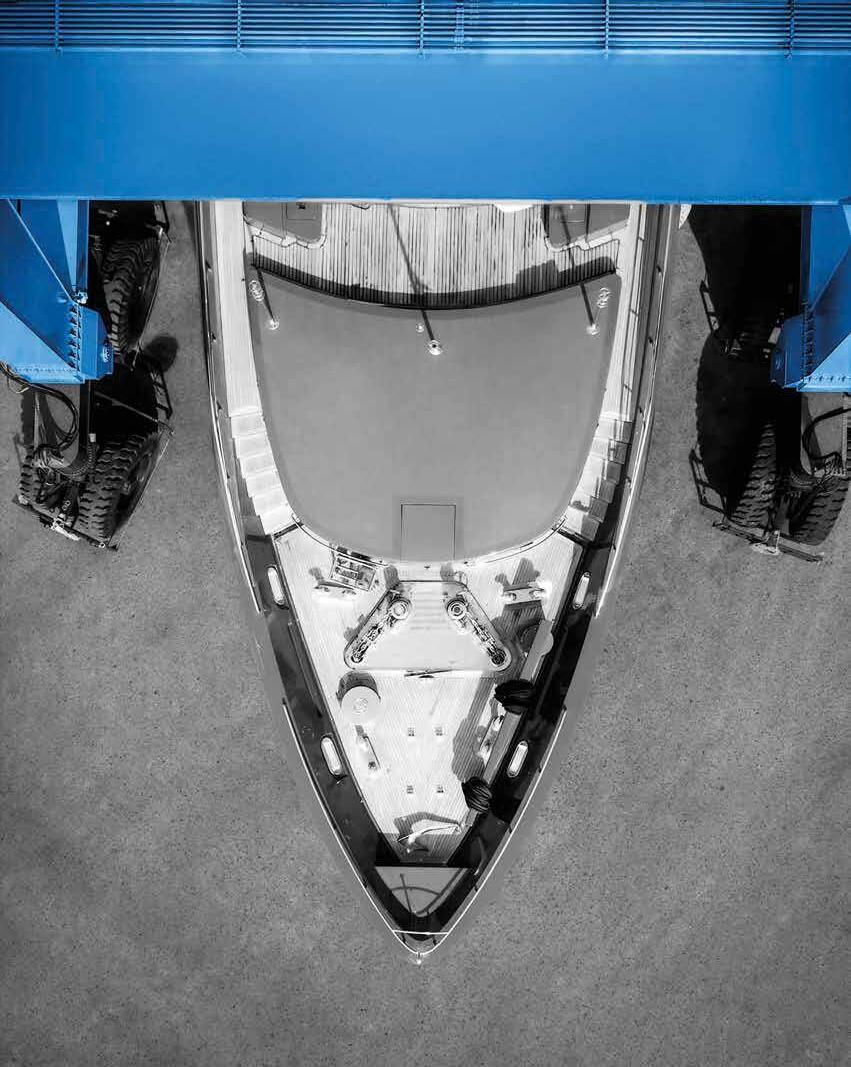
F/Yachting has arrived to change the superyacht interiors landscape, and with its roots in the private aviation sector is coming to the market with a clear objective as an innovator, gamechanger and partner.
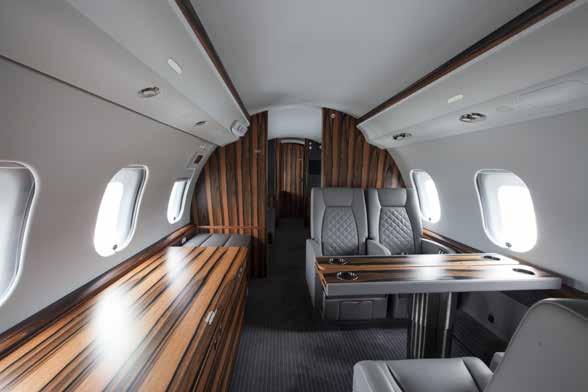
BY MARTIN H. REDMAYNE
Earlier this year, I was invited to fly to Vienna to take a short journey into the Austrian countryside, a long, long way from the ocean, to visit the F/LAB and witness the launch of the new division of F/List, called F/Yachting. To be honest, I rarely do press trips like this, but I’d never been to Vienna and I’ve always been fascinated by the processes and ideas that emerge out of the interior subcontractor world and, to be honest, I wasn’t disappointed.
As a market sector, we’ve seen various corporate casualties, collapses and bankruptcies, takeovers, rescues and integration in the shipyards themselves, as contracts for some of the largest yachts in the market have stretched the capacity and stability of some suppliers. We’ve seen interior build pricing climb to astronomical levels and the complexity of interiors add more and more cost and time to the delivery of some famous projects.
It’s often when designers have pushed the project in a direction that may not always make sense, but have ego and awards/ideas that have little consideration for the builder or subcontractor that are the result of a crazy dream sold to a client.
After some detailed analysis of the market and the interior build sector, there are other factors that I’ve found both shocking and needing attention. There’s a vast volume of waste materials, as designers or quality-control processes reject perfectly good materials in search of obsessive perfection, with little consideration to the repurposing or reusing of these rejected materials. There are the logistics and eco-impact of sourcing rare materials around the world for one specific veneer finish on a single cabinet that then has its own dedicated truck from the factory to the shipyard and then back again … empty.
With a seriously impressive order book over the past ten years, it’s easy to see how pressure and stress has been imposed upon this sector which was never set up for the tens of thousands of square metres of super luxury interior, with long lead times and short installation periods. Many of the major brands have evolved from land-based architecture and, due to quality or proximity, moved into the

large-yacht arena, excited at the numbers and level of detail. However, the market pushed them to a quality of finish never seen before.
With passions and expectations always running high in yacht projects, reworking, project delays and minds constantly changing, it’s clearly a sector not for the faint-hearted. Perhaps the rapid increase in prices per square metre were part of a financial mitigation strategy, Covid-induced man-hour management or even a list of additional costs that many manufacturers have been battling: energy, raw materials, insurance, shipping and interest rates.
When you walk around a large superyacht today, even a small one, there’s an awe-inspiring gasp when you see the intricacy or attention to detail, when you hear how many hours were spent waxing and polishing rare woods, when you see handcarved architraves or unique inlays with hundreds of different finishes and you walk into a room that is designed to be a personal statement of excellence and opulence.
However, after a conversation with one very wealthy yacht owner, he questioned the need for such a high level of perfection and cost, especially when we spend only a couple of months a year on board. More importantly, he added, “When I sell my yacht, chances are someone will want to change my precious interior.” Perhaps we have gone too far.
If you’ve ever been invited to a billionaire’s home, villa, apartment or chalet, or walked through an ultra-luxury resort property or dined in an exclusive members club, I wonder if you’ve ever considered, compared or contrasted the level of interior quality






that their occupants live with every day. The chances are that the interiors are nothing like the level of quality that we drive into our market and, more importantly, nothing like the costs either.
If you’ve ever been lucky enough to step on board a Boeing Business Jet or Gulfstream en route to any of the above, you may have rested your hand on a stunning cabinet or crafted work station built in Thomasberg, Austria at the F/List factory. Many superyacht owners who may have one or more planes in their fleet of assets will have F/List interiors, built beautifully, carefully, technically and accurately in partnership with the private jet manufacturers and various designers.
From my whirlwind visit to the factory, it was very clear that this partnership is critical because safety, accuracy, weight, material use and installation are all a fundamental part of the process and all is carefully mapped out well in advance of any aviation build. Obviously, weight is a critical factor and some of the material regulations are super stringent and strict, but it was more the planning and project management that seemed to bring so much to the table.
With only 300 small-bodied private jets being built per annum and approximately 20 large-bodied private jets in the same calendar, there are some clear similarities with the market scope and size. Obviously, the fuselage and volumes are far more controlled and fixed, but it’s some of the working processes that may need some investigation.
The concept of working closely together (interior builder and jet builder) at the very outset of a project, to make sure something makes sense and can be built intelligently, accurately and within
a smart budget with a realistic margin, is where the partnership makes so much sense; coming up with workable and logical solutions, creating innovations and smart ideas that inspire the guests on board or bring interior intelligence to the table. Yes, there are incredible finishes and tactile materials but it seems that the partnership is not only long term with multiple projects in the contract, but also financial, so the subcontractor/builder relationship is economically stable. I think there’s a lot to learn from the world of private aviation.
Over the past 30-plus years, F/List has worked stealthily with various contractors and shipyards, adding much-needed skills and capacity in the market. Not to be confused with List General Contractor (List GC), but part of the same carpentry dynasty in Austria, F/List is a ‘parent’ company run by the dynamic CEO Katharina List-Nagl, granddaughter of the great founder of the Franz List empire. To avoid confusion and to remove the concept of two Lists in the yachting sector, a new brand was agreed upon. After much debate and discussion, the name that is worth adding to your specification list is F/Yachting.
Managed by two experienced characters –Werner Kartner and Andreas Aigner, CEO and COO respectively – guided by the manufacturing and innovation principles of the parent company, this is an exciting addition to the market. In combination with the new F/LAB (more of which later), F/ Yachting wants to bring something new to the perfectly crafted table.
Similar to the partnership strategy they have
Similar to the partnership strategy they have developed in aviation, the F/Yachting strategy is very clear: build first-class, world-class interiors, delivered on time and on budget and make a profit at the same time.

L-R: F/List COO Andreas Aigner and CEO Werner Kartner with List CEO Katharina List-Nagl.
developed in aviation, the F/Yachting strategy is very clear: build first-class, world-class interiors, delivered on time and on budget and make a profit at the same time. It sounds so logical and simple. Following my visit to their pristine factory, meeting the management team across the whole company and witnessing some of the build programmes and innovations they have in place, it’s clear that they are not going to deviate from their course; they’re on a mission.
Imagine an interior subcontractor who is sitting in the same meeting with the owner, the design team and the project-management team before a contract is signed at the yard. Consider an interior subcontractor who works with the interior designer to brainstorm and debate better ways of making a fixture or installation or finish work, so it’s more efficient and optimises the material use. Think about an interior subcontractor who works with the design team, project team and build team, right at the start of the project to plan and manages the process of installation in conjunction with other critical subcontractors, so there are fewer impacts and minimal delays.
What about an interior subcontractor who presents new materials or smarter materials that will save energy, cost and reduce maintenance?
Then consider the interior subcontractor who wants to build an interior that is designed to be upgraded and repaired, with a life-cycle strategy and logic applied to removing and replacing key aspects of the interior.
This forms the backbone of the F/Yachting ethos and has been labelled their 361-degree service strategy, where the interior is considered for life and all elements of it are planned, optimised and installed to ensure that time is not wasted, money is not burnt and materials are chosen based on more important factors such as levels of use, interaction and feel, social and planet impact and source, not just choosing the most rare and obscure just to be part of an obscene dinner conversation.
Alongside the new F/Yachting business, Katharina List-Nagl invited a few close friends, a handful of aviation and yachting clients and some of the media to join her for the launch of their new research and innovation laboratory, labelled the F/LAB. For obvious reasons, the lab remained behind closed doors, but everyone was treated to a taste of the smart ideas and inspiring solutions that have come out of the early stages of the laboratory’s development.

Safe hands, synchronized by heart and brain: Whether your yacht was born a LÜRSSEN or not, you can trust on class-leading engineers, facilities and highly skilled craftsmen ready to refloat your dreams. Discover the difference.

F/LAB showroom.
Upcycling, recycling, reusing and repurposing in combination with a sustainability mission will allow F/Yachting and any yacht designer to explore eco-friendly solutions.
Their mission is to bring together engineers, designers, technologists and scientists to explore ideas and solutions that will push boundaries and challenge the norm. Rather than source rare materials, woods and skins and planet-unfriendly finishes, they will be in partnership with some of the brightest minds to develop revolutionary new materials that will inspire and impress.
Upcycling, recycling, reusing and repurposing in combination with a sustainability mission will allow F/Yachting and any yacht designer to explore eco-friendly solutions that will allow a client to have a smarter conversation about their planet-friendly finishes rather than a rare material extracted from a rainforest and less than one per cent of the wood used in the finished product.
The F/LAB was a really interesting experience, and over the coming months we’ll share more details of some of the results of the laboratory; proprietary materials such as Whisper leather, Aenigma and Linfinium will be worth investigating further.
Every element of these materials has raw-material sourcing, local supply chain distances and renewable energy, and there’s a positive impact element to the application. Imagine having the time, ideas and vision to work with a sub-contractor to create brand new materials that not only make you feel good, solve a problem and use waste materials smartly, but also have a commercial strategy for other projects too.
With a strategic vision of F for Future, both F/ Yachting and the F/LAB are coming to the yachting market with a clear objective – not as a disruptor, but as an innovator, a game-changer and a partner. Perhaps the time has come to remove the term ‘ sub’ as in sub-contractor; due to the investment being made in the complex and creative interiors with millions of euros at stake, they should be treated like fundamental partners, from the start of the owner’s dream all the way through the lifecycle of the yacht. MHR
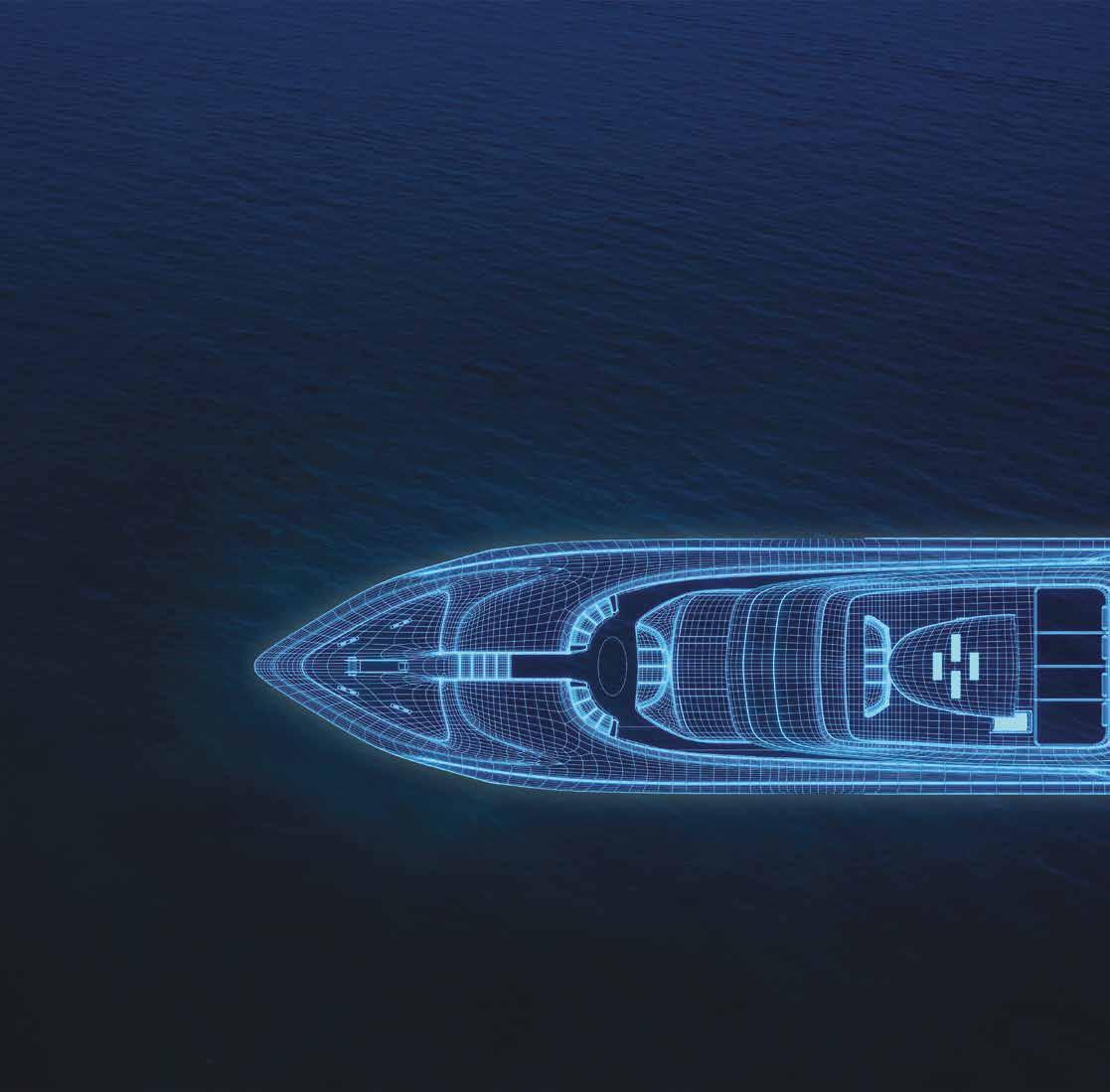
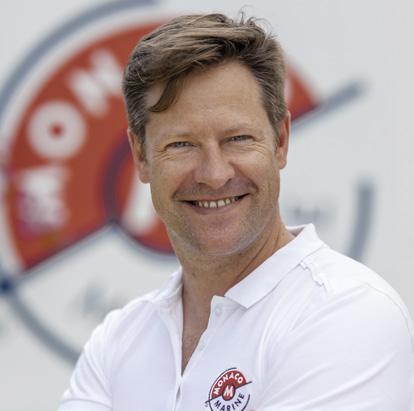


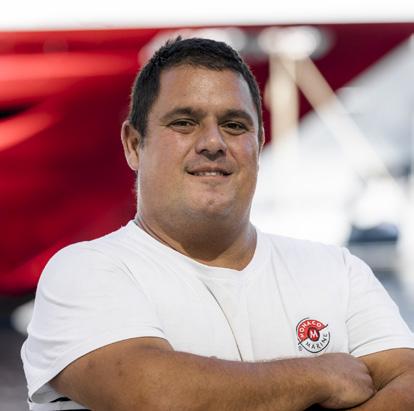
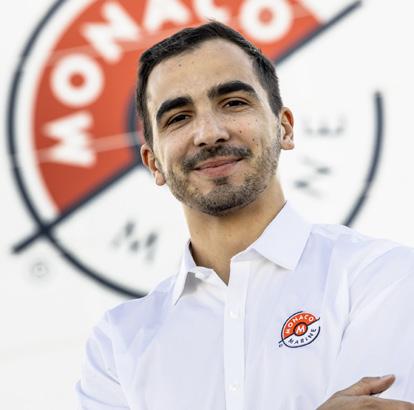







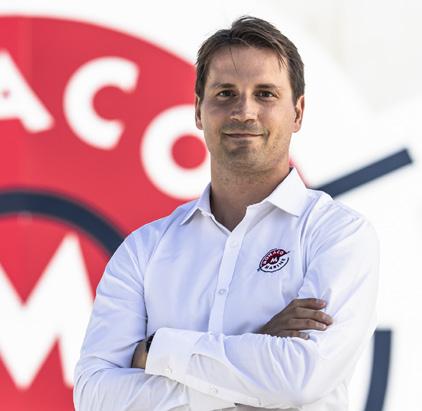
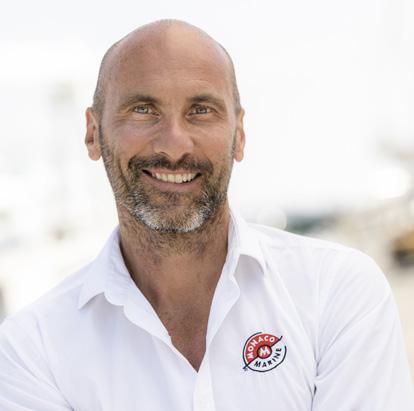
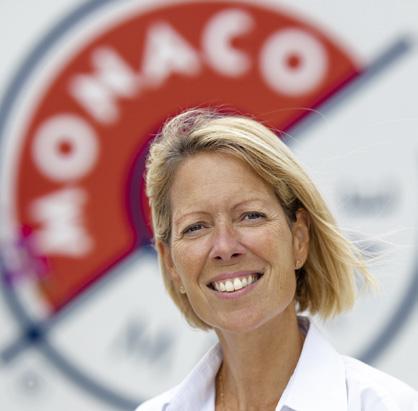



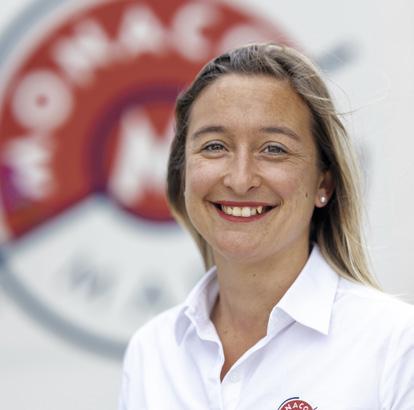

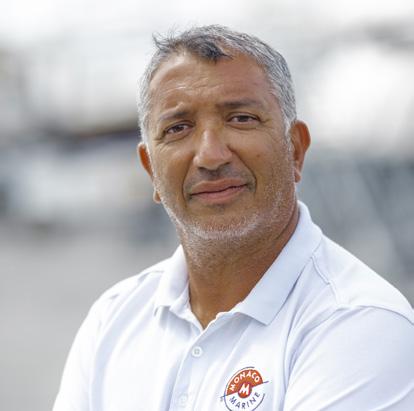


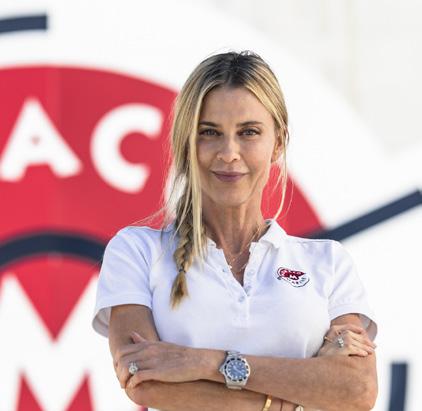

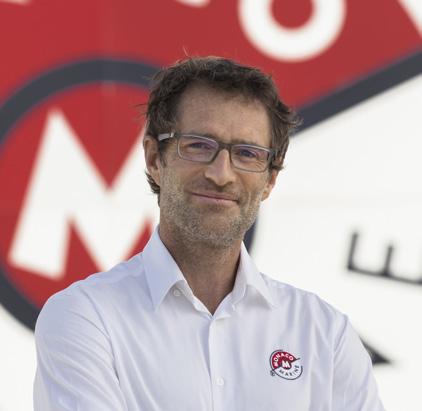

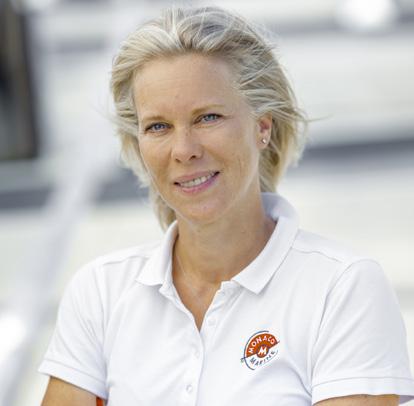
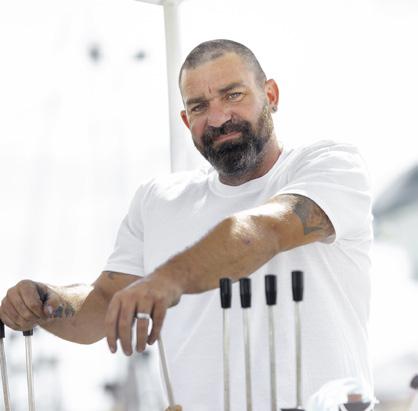
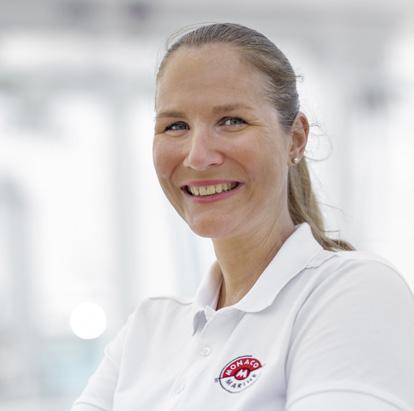

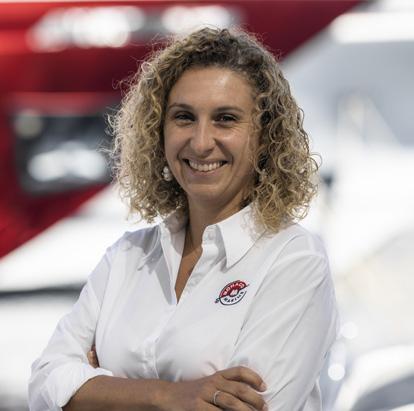


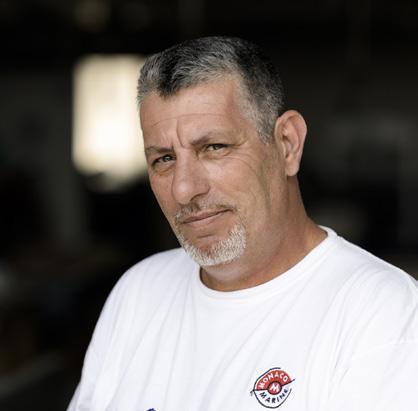



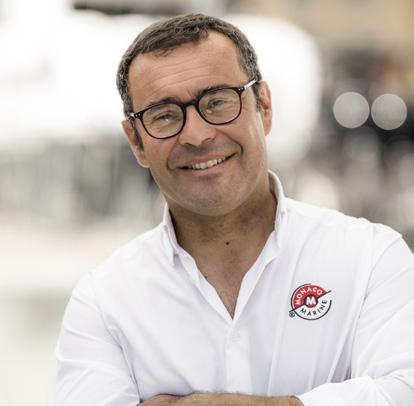
CEOs’ views on the future
BY SUPERYACHTINTELLIGENCE.COM
A comprehensive and fascinating insight into the minds of market leaders in the superyacht industry which reveals their current thinking as well as their ambitions for the next few years.
Earlier this year, our CEO and Chairman, Martin H. Redmayne, invited the business leaders of our industry to take part in a CEO sentiment survey to assess the perspectives and opinions of the market principals. The survey was shared with a broad spectrum of industry leaders, investors and entrepreneurs, and the project is still ongoing to increase the level of depth and outreach to the industry.
The full results of the CEO survey will be published as a standalone document and made available for download later this year. In the meantime, The Superyacht Agency has compiled the most interesting and relevant results from the current response pool.
Editor’s note: All graphics and results in this article represent the current responses from the survey and are subject to change as more participants take part.
The demographic breakdown of the CEO survey highlighted the broad spectrum of companies within the industry and the multi-faceted approach that different individuals can utilise to join the yachting space. Companies represented ranged from brokerage firms to shipyards and suppliers. In fact, supplier CEOs accounted for 29 per cent of our survey respondents, followed by service companies at 19 per cent and shipyards at 15 per cent. In terms of the ‘other’ category, this included CEOs from companies involved in media, marketing consultancy and ocean marine research.
Interestingly, the size of the companies represented in our survey varied along the spectrum, ranging from one to 10 employees all the way up to more than 200. The largest proportion represented came from the 1-to-10 employee category, with 36 per cent of respondents
indicating this was the direct number of employees that they currently employ. This was followed by the 10 to 25 employee category at 25 per cent, with the over-200 employee category taking the third highest spot at 14 per cent. This highlights the variety and wide spectrum of CEOs who took part in the survey and provided their valuable input into this market piece.
In terms of employee retention and stability, our CEO respondents indicated how the number of people they employ had changed over the past 12 months. Some 67 per cent said their employee numbers had stayed the same, suggesting a fair level of stability within the industry, while 19 per cent indicated they had significantly grown in numbers which, again, is encouraging for industry staffing figures. However, 10 per cent of CEOs in our survey admitted that they wanted to hire but were struggling. There could be a number of reasons
for this: a lack of awareness about the industry to recruit new talent, the shortage of skills being passed on from master craftsmen to the next generation or individuals struggling to bridge the gap from offshore to on-shore work. This is where the importance of specialist recruitment firms and the acknowledgement of so many transferrable skills that can be applied to our industry need to be recognised.
Revenue is at the heart of all business practices and our CEOs very candidly shared which revenue/turnover bracket they felt their company was placed in. Almost one-fifth indicted that the revenue bracket for their company was €500,000 to €1 million; however, the next two top-rated revenue brackets differed quite significantly. Both accounting for 13 per cent of CEO representation were
the €10million to €25-million and over €100-million brackets. This variance in revenue is interesting in many ways, signifying the large success of many companies within the industry and also how much that success can vary.
When asked about the percentage change in turnover/revenue their companies had seen over the past three years, 27 per cent of CEOs said it had increased by more than 15 per cent; increases
of both five to 10 per cent and 10 to 15 per cent were given in 20 per cent of responses.
This further highlights the success and growth for many companies within the superyacht industry in recent years. This theme of financial productivity is reflected further in the various net profit expectations for 2024, with 34 per cent of CEOs expecting to make a net profit of between five and 10 per cent and a
further 30 per cent predicting that their net profit for this year will be between 10 and 20 per cent.
Staying in the sphere of finance, CEOs were also asked to report on their operating costs and raw-material prices and what percentage change they had seen over the past two years. Some 27 per cent revealed that their costs had increased by 15 to 20 per cent. What makes this data particularly interesting
is when the responses to operating costs are segmented by company type.
As can be seen in figure 5 overleaf, there was a big disparity among brokerage CEOs, with some reporting that their operating costs had not increased at all, while others reported increases of between 15 and 20 per cent. Shipyards reported varying levels of price increases, ranging from no increases all the way to costs and
materials rising by more than 30 per cent. For shipyards in particular, this variance in costs and raw materials is important to note because many within the industry cited the rising new-build costs that are being seen by clients, with the observation that many are opting to upgrade current vessels rather than produce new superyachts because this can save on both costs and the time investment required.
Commercial expectations among our CEO survey pool revealed an overwhelming majority of 57 per cent of respondents sharing that in the next five years their commercial expectations were for consistent and stable growth. Stability and growth were key sentiments among respondents, as only four per cent indicated that they were concerned about uncertainty with potential market declines.
In terms of potential commercial concerns, our CEO respondents were clear: 37 per cent revealed that their biggest commercial concern was current uncertainty in the world. This was by far the most highly rated concern reflecting the response to current global issues from our industry leaders. These concerns are valid and expected, with the geopolitical issues around the world such as the Russian invasion of Ukraine, the

Gaza-Israel conflict and the impending upheaval that could result from the presidential election later this year in the US.
The analysis also revealed other key commercial concerns: 11 per cent of respondents believed that their biggest worries were both rising costs/finances and the public image of the industry. This public image has long been a point of discussion, with the perception being that of extreme opulence and wild times at sea, whereas many in the industry know this is far from the reality. This distorted public image is understandable in terms of commercial concerns as companies that may wish to expand outside the yachting sector may face unfounded doubts and rebuffal from those who do not truly understand the nature and nuances of the market.
Figure 7: Confidence in company’s ability to sustain growth over the next 10 years
Figure 6: Commercial expectations for companies in the next five years
Figure 8: Biggest commercial concern

Supporting Superyachts. Built for purpose.
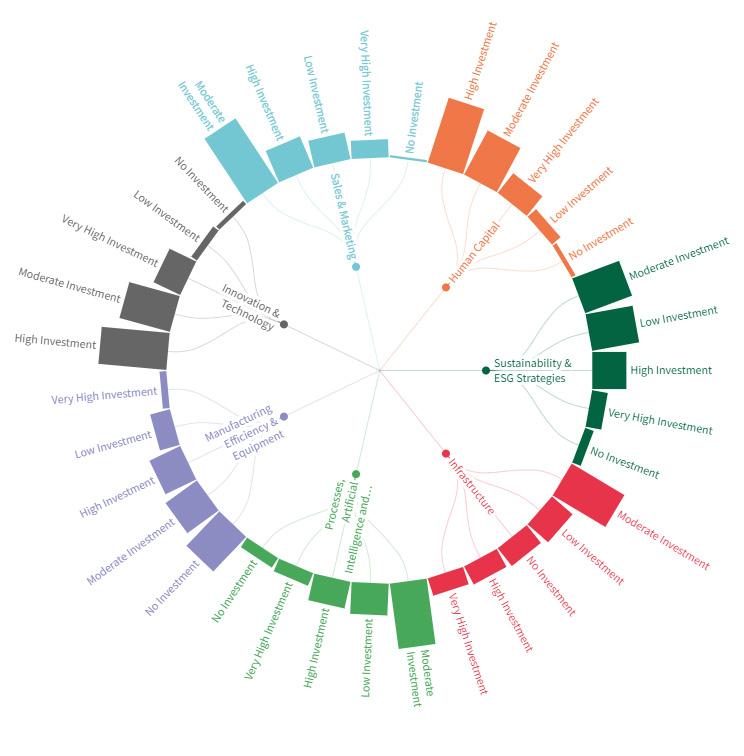
When it comes to investment from the leaders of our industry, there was a wide range of responses. Both Innovation and Technology and Human Capital were selected as the most frequent areas to receive high levels of investment by CEOs, emphasising the response from the industry towards the growth and evolution of technology and the way it can change and overhaul certain elements within operations, marketing, design and much more. The investment in human capital is also crucial; as reported above, the majority of companies in the industry have maintained the same level of employees for the past 12 months, while others want to hire but are struggling, all of which links to the need for investment in human capital.
Strengthening client relationships was the top strategic plan and initiative that companies were planning to prioritise for the next five years, and this was followed by improving operational efficiency and reducing costs. Based on indications shared previously by the CEOs in our sample, this emphasis on reducing costs is unsurprising because this was highlighted as a commercial concern by 11 per cent of the CEOs.
Additionally, over the next five years, respondents highlighted that the biggest challenge to their company would be human resources and skills shortages, further emphasising the sentiments expressed earlier about recruitment, the passing on of skills and how the industry is potentially limiting its growth through its employment numbers. Sales and Business Development and Increased Competitive Landscape were the secondary and tertiary sectors also seen as major challenges for companies in the industry, highlighting our CEOs’ acute understanding of changes and developments that are present in the industry.
CEOs were asked to share what they believed to be the most significant area of growth for the superyacht industry. Around 36 per cent identified refit and rebuild of the fleet as the most significant growth area for the market.
Figure 10: Strategic plans and initiatives companies are prioritising over the next five years
"Strengthening client relationships" "Improving operational efficiency and reducing costs" "Expanding into new markets"
"Growing organically"
"Investing in new technologies"
Figure 11: Biggest challenge for companies in the next five years
*Other includes: • Change way of
• Yachting industry’s mindset and poorly managed companies
SHOULD WE REBRAND?
cent,as delaysdue relatedtoCOVID-19.Asimilarlevelling numbersisexpectedin2022,resultingin evenspreadofdeliveriesandthereforemarketvalueacrossthenextfewyears.Italianbuiltyachtsaccountedfor33percentofthe marketvaluein2021,andatpresent,accountfor39 percentoftheorderbookvalue.Yachtsconstructed intheNetherlandsaccountedfor31percentofthe marketvaluein2021,andatpresentaccountfor 25.4percentoftheorderbook.
WHAT DO STAKEHOLDERS THINK OF US?
WHO IS OUR IDEAL CUSTOMER?
WHICH REGION ARE WE BEST KNOWN? HOW DO WE COMPARE TO OUR COMPETITORS?
WHAT MARKETS ARE A PRIORITY FOR GROWING OUR BRAND?
Great decisions don’t start with assumptions. Let us provide the answers.
Using bespoke quantitative surveys and qualitative interviews, our data and research consultants provide real insights and analysis around the market's perception of brands and businesses. Scan the QR Code to see our work.
Figure 12: The most significant area of growth for the industry
writing. utionto superyachts €1,250/sqm;5,138sqm.These Italy&
Figure 13: The biggest threat or challenge to the industry
“GEOPOLITICAL & FISCAL INSTABILITY”
Figure 14: Optimism about the overall growth prospects of the industry
This is significant for the industry as the superyacht fleet is currently at just over 6,000 vessels, providing a large captive audience for potential refit and rebuild. This provides the opportunity for existing vessels to be upgraded and future-proofed to meet the changing demands of the industry, such as environmental regulations and differing design styles.
Sentiments about growth prospects were for the most part positive, with 54 per cent of CEOs agreeing that they were cautiously optimistic regarding the growth of the industry. This is understandable considering the earlier responses relating to geopolitical instability and concerns regarding rising costs. However, this cautious optimism is encouraging because it shows the overall mindset of the leaders of the industry and how they believe that the market will continue to grow and develop in the coming years.
Twenty-nine per cent of CEOs were neutral in terms of growth, and this can be equally attributed to the current circumstances facing the global economy and political stations; this neutrality signals the shrewdness of certain business leaders in their approach to business development and their potential patience to see how particular situations unfold in the coming months and years.
The word ‘cloud’ (figure 15, overleaf) represents what our CEOs held as their reasoning behind their perspectives on the industry’s future growth potential. As expected, geopolitics was the number one reason highlighted, marked by its large presence within the word ‘cloud’. Costs and market downturn also featured quite extensively in the response pool, indicating an awareness of the broader economic and market situations facing not only the superyacht industry, but also the wider supply chain and economic policies of many countries and markets. Refit again featured as a justification for certain CEOs’ opinions on market growth, further cementing the view that the future growth and potential opportunities for the market lie in the refit and rebuild of the current superyacht fleet. Customers, generations
and young people were also mentioned as many CEOs cited the transfer-ofwealth phenomenon that is being heavily reported on at the moment, which could transform and evolve the nature of superyacht ownership in the coming years. This reasoning was used both in a positive and cautious light, with some CEOs seeing this client demographic shift as a positive for the industry, whereas others were cautious, indicating they were unsure what the future would hold and whether younger UHNWIs would have the same affinity for the superyacht industry as the generation before them.
The quotes in figure 16 present a snapshot of CEO opinions about what fundamental changes they would like
to see within the industry by 2030 to help improve business performance and ensure long-term market resilience. The thoughts from some of the industry leaders ranged from the ever-green topic of sustainability to the evolution of the overall public image of the yachting industry.
Conclusion
On the whole, this survey has provided a fascinating insight into the minds of CEOs in the superyacht industry and their viewpoints on the market. Some clear themes have emerged, such as the vital importance placed on employee retention, human capital and the need to recruit more into our industry to aid its
growth and evolution. The importance placed upon refit and rebuild as the next great opportunity for the industry is an exciting prospect, and this could be an interesting market space to observe and report on over the coming years.
The research and findings from this survey will continue to evolve as we aim to reach out to even more individuals within the industry to grow and develop the number of opinions and voices taking part. When this research is expanded, a comprehensive standalone report will be published and made available to enable these findings to reach as many people as possible within the industry and to potentially inspire the next generation of superyacht CEOs.
Figure 16: Fundamental strategic changes CEOs would like to see in the industry by 2030 to improve business performance and ensure long-term market resilience
“Realistic fossil fuel (energy) alternatives. Technological advances in ocean manoeuvring that lessen our ecological footprint but increase access. We need a lot more science to support more informed decision making for technology and for policy.
We need knowledgeable brokers. Brokers have too much influence in the yacht industry when most of them are not qualified at all.
The superyacht industry needs to get an updated public image. Instead of being known for serving a little group of UHNWIs, it should be known for employing thousands of companies and workers worldwide and its unique chance of creating business with the highest quality of craftsmanship.
More investment in research and development of new models and technology with principles of flexibility for clients, along with more optionality in the commercial arrangements for aquisition.
Expanded cruising destinations and marina facilities.
More stability in the workforce, especially the key players.
A shift away from exclusivity and luxury towards social responsibility and leadership.
Better PR and improve international image of industry.
All market participants should work more together and less against each other. The international and national associations could take on a communicative role here.
Having regulations that are correct for the operational profile of yachts.
More research to help US and other countries understand where the opportunities lie.
By 2030, I envision the entire supply chain of industry and all clients embracing sustainable practices and advanced technologies to enhance efficiency, security and innovation. Additionally, fostering flexible workforce models, robust cybersecurity measures, ensure long-term market resilience and adaptability to future challenges.
More compliance and regulatory requirements to improve the operational standards, become more customer-centric and improve reputation of the industry by meaningful sustainability innovations and efforts.

The CEO survey is still live and open to new opinions, sentiments and thoughts from the leaders of our industry. If you are interested in taking part, please scan the QR code.
Guest Column
by Christophe Bourillon
The world of superyachts has long been synonymous with luxury, exclusivity and unparalleled privacy. However, as global attitudes shift towards sustainability and social accountability, even the most discreet sectors are facing new challenges.
Superyacht owners, who have traditionally operated with a level of discretion and autonomy, now find themselves navigating a landscape where environmental responsibility and ethical employment practices are no longer optional. To attract top talent and maintain a positive public image, owners must adapt in several key areas.
Embracing sustainability in yacht design and operations
Historically, the environmental footprint of yacht building and operation has not been considered as a key priority. However, as public demand for climatefriendly solutions and ocean preservation grows, so too does the demand for sustainable practices within the superyacht industry.
Green technologies and eco-friendly design
Owners must invest in greener
technologies to reduce their vessels’ environmental impact. This includes hybrid or other innovative propulsion systems which significantly reduce carbon emissions compared to traditional diesel engines. Additionally, integrating solar panels, wind turbines and energy-efficient systems into a yacht’s design can further decrease reliance on fossil fuels.
Eco-friendly design also extends to the choice of materials. Using sustainable materials for interior finishes and furniture not only minimises environmental impact, but also ensures a better living environment for crew and guests alike.
Waste management and ocean protection
Proper waste management is crucial in protecting the delicate marine ecosystems that superyachts frequently explore. State-of-the-art wastetreatment systems to manage sewage, greywater and solid waste are available. Additionally, reducing the time that water lights are used at night and minimising noises that disturb marine life further demonstrate real commitment to ocean preservation.
Attracting top crew through ethical employment practices
A superyacht’s success hinges on the quality of its crew, who ensure that every aspect of the owner’s experience is seamless and enjoyable. However, the best crewmembers are increasingly selective, favouring employers who demonstrate a commitment to fair labour practices, career development and well-being.
Fair wages and employment contracts
To attract top talent, owners must offer competitive wages that reflect the demanding nature of the work. Transparent, fair employment contracts are also crucial, providing clear terms regarding working hours, leave entitlements and job responsibilities. Ensuring that these contracts comply with international labour laws not only protects the crew, but also shields the owner from legal and reputational risks.
Career development and continuous training
Offering opportunities for career advancement is another key factor in retaining high-quality crewmembers. Superyacht owners should invest in continuous training programmes,
enabling crewmembers to enhance their skills and advance their careers within the industry. On-board training is a fantastic way to foster team-building. In addition, encouraging a positive onboard culture that values teamwork, respect and well-being can significantly improve crew satisfaction. Providing access to mental-health resources and ensuring crewmembers have adequate rest periods are critical in maintaining a healthy and motivated workforce.
Public accountability and corporate social responsibility (CSR)
Ever since the ‘oligarch sanctions issue’ landed superyachts on the front pages of the mainstream media, ours has become a controversial industry and, whether we like it or not, we must now be accountable to the public and communicate on the reality of our industry. The increased scrutiny of the superyacht industry means we can no longer afford to be a discreet industry. Transparency and accountability are
now indeed expected, particularly when it comes to environmental and social responsibility.
Transparency in operations
Superyachts are now tracked and followed by a number of public websites and applications where they are directly linked to their owners. These vessels can enhance their public image by being transparent about their efforts to reduce environmental impact and improve labour practices. This could involve publishing sustainability reports encompassing all yacht operations or certifying their yachts with eco-friendly labels. Many yacht owners are senior executives of large companies where they implement these practices. In some ways, they should apply the same operations measures to their yacht that they apply to their business units.
Engaging in CSR Initiatives
We are seeing more and more owners engaging in CSR initiatives that

align with their values and passions. This ranges from supporting local communities in the destinations they visit to funding marine conservation projects. These CSR activities contribute to generating a new and evolving perception of superyachts, more in tune with our times.
Conclusion: charting a course for the future
As the world moves towards greater sustainability and social responsibility, superyacht owners will continue to adapt to these evolving expectations. By embracing green technologies, adopting ethical employment practices and engaging in CSR, owners can attract the best crew and ensure their superyachts are seen as examples of responsible and forward-thinking stewardship.
Navigating these changes will not only preserve the allure of the superyacht lifestyle, but also contribute to a more sustainable and equitable future for all. CB
The increased scrutiny of the superyacht industry means that we can no longer afford to be a discreet industry. Transparency and accountability are now, indeed, expected, particularly when it comes to environmental and social responsibility.
»
»




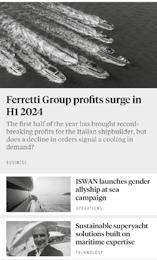

We report on how incorporating more eco-friendly practices can benefit owners and guests while not negatively affecting their on-board experience.
BY MEGAN HICKLING
It seems many people give up on the idea of sustainability and superyachts coexisting because the overconsumption, excess and waste involved seem antithetical. The results from our Captains and Senior Crew Survey featured in our previous issue revealed that only 48 per cent of respondents stated that environmental sustainability is important to their owners and guests.
Many respondents indicated that sustainability is not a concern because of the nature of superyachts, echoing sentiments such as “They are just toys for the rich and famous” and “It is beneath them”. One noted, “If they cared about the environment, they would not have one.” However, the same could be said about much of modern life in the Western world, such as owning cars or taking short-haul flights.
While we cannot entirely eliminate our environmental impact without drastically changing our lifestyles, it doesn’t mean we shouldn’t make efforts to improve. Similar criticism is made of environmentalists – that they need to be perfect individuals, whereas it’s more important for everyone to make any amount of change for the better.
The lack of prioritisation of sustainability by guests and owners suggests that the push for improved environmental
impact needs to come from key decision-makers and influencers within the industry. It’s crucial to show that incorporating more sustainable practices can benefit owners and guests while not negatively affecting their on-board experience. There are already various methods, big and small, being adopted within the industry that prove this is possible.
What can be done now?
A key concern mentioned by the survey respondents is the perceived additional cost of implementing eco-friendly alternatives. Comments such as ‘expense and availability of alternatives, those that do exist have a heavy premium and risk’ and ‘cost factors of environmentally friendly products and methods’ highlight this issue. While some owners and guests want the best money can buy, many don’t see the value in a less negatively impactful yacht. However, numerous options exist that don’t cost extra and can even save money.
The best example of this is energy savings and other fuel savings: reducing the amount of fuel burned by generators and engines decreases harmful emissions and reduces fuel costs. Several strategies can achieve this including using shore power whenever possible, running at
lower speeds, optimising generator RPM, and reducing HVAC and lighting use. Switching to HVO fuel or other diesel alternatives, where available, is another way to reduce emissions.
A yacht’s impact goes beyond emissions, including waste generation such as trash, black water and grey water. Many ports and marinas accommodate appropriate disposal but it requires the crew’s understanding and facilitation. Efforts can also be made to reduce the waste generated on board; a common example given in the survey was reducing single-use plastics such as water bottles by installing water filters or remineralisers. Efficient purchasing, which involves buying only what is needed, can reduce food costs and waste. Changes in purchasing can also include using more local produce to reduce fuel miles, using coffee beans instead of pods, and using toxic-free cleaning products.
Such on-board changes can have minimal effects on the luxury experience if implemented intelligently. However, as many changes are behavioural, they require crew understanding and commitment. Water Revolution Foundation has recognised this, and the potential power that crew have to reduce the impact. It has released crew guidelines that detail ways to reduce environmental impact across different departments without affecting the on-board experience. Involving crew in these efforts is particularly effective because they can be more engaged in improving impact, as is apparent from the survey and my piece ‘Crew Blueprint for a Greener Footprint’ in our recent Operations Report.
This aspect can also be incorporated within an ESG (environmental, social and governance) strategy for a vessel. An effective ESG strategy ensures that environmental, social and governance elements interact and support one another. For example, the social aspect encompasses improved operational policies and procedures by the crew and
investments in their mental health, wellbeing and safety.
Addressing these aspects can help combat high crew turnover because crew can feel involved in making a positive impact and so don’t leave. The governance aspect involves ensuring safety, security, policy, procedure and compliance. It involves the decisionmaking processes underpinning ESG strategies, including planning and formalising of efforts to integrate these goals into tangible actions on board, ensuring a cohesive and effective approach.
While many changes can be implemented across the fleet immediately, other changes with varying effects can be made at the refit stage to achieve impact reductions. Installing more energyefficient equipment, such as lights and electronics, is one such change although, ideally, unbroken replaced equipment should be recycled or repurposed.
Larger-scale systems such as HVAC systems can also be updated. For example, using a system where rooms are individually climate-controlled can prevent unnecessary energy consumption. Waste-heat-recovery systems, which use exhaust heat for warming, generating electricity or producing cold air, can lead to an estimated 10 to 15 per cent emissions reduction, as highlighted by Water Revolution Foundation.
Deciding what to implement during a refit to reduce a yacht’s impact can be guided by a YETI assessment from Water Revolution Foundation. The resulting report provides recommendations for reducing the vessel’s environmental footprint. Typical recommendations include switching to HVO fuel, installing diesel particulate filters to reduce exhaust emissions and installing selective catalytic reduction (SCR) systems to reduce NOx emissions. One survey respondent noted that cleaner exhausts also improve the on-board experience.
Future-proofing vessels by immediately adopting less harmful methods protects owners and guests from the consequences of non-compliance, whether that is financial penalties or the inability to enter emissionscontrolled areas.
While changes can be made at the refit stage, improved solutions can be implemented at the beginning of the lifecycle during new builds. The most extensive change would be using lowemission power alternatives such as hydrogen, diesel-electric or methanol/ ammonia systems.
One respondent comment provides the interesting insight that nowadays some owners do increasingly wish to make tangible, quantifiable impacts, whether that’s the visibility of some of these changes that keeps the impact reductions at the forefront of the mind or the quantifiable cost and impact reductions that can be measured. These changes allow owners and guests to feel they are positively impacting the planet, reducing potential guilt.
One respondent said, “It would create guilt, which isn’t in line with having a good time on board. So it is ignored.” However, with mounting pressure to act better, this guilt may be there anyway, and implementing these solutions can alleviate it. The bigger question remains: with various solutions available, how can we overcome ambivalence and work towards improving the industry’s impact on existing and new vessels?
Why making these improvements matters
Despite the overall lack of concern felt by owners about improving their yacht’s sustainability, there are many reasons to work on this issue now.
Whether they are working to change their yacht’s environmental footprint or not, the impact on the environment and the resulting changes will likely affect the operations of many yachts. More extreme weather, such as Hurricane Beryl this year, which was exceptionally early and intense, is a trend likely to continue affecting operations in the Caribbean. Similarly, Mediterranean areas like the Greek islands are experiencing more frequent and intense wildfires.
Sea-level rise will probably continue, affecting coastal areas popular with yachts. These examples highlight how environmental changes affect areas frequented by superyachts, impacting itineraries. While these moral reasons may not persuade owners, it may lead to those surrounding them, such as family members, beginning to question any lack of impact mitigation, encouraging behaviour shifts.
ESG-related regulations have increased by 155 per cent over the past decade, with 1,255 ESG policy interventions introduced worldwide since 2011. Currently, only some directly affect yachts, primarily through IMO tiers for engine NOx emissions and EU regulations such as the Corporate Sustainability Reporting Directive (CSRD) affecting industry businesses. The EU emissions trading system currently affects commercial vessels above 5,000 gross tonnes. It is forecasted to extend to include other ship types and sizes, likely including more yachts, incurring significant costs across the fleet.
A continued increase in ESG regulations is likely, in the form of emissions limits, particularly affecting future designs. Future-proofing vessels by immediately adopting less harmful methods protects owners and guests from the consequences of non-compliance, whether that is financial penalties or the inability to enter emissions-controlled areas.
Governments and the general public are increasingly understanding the detriment of inaction on environmental issues and the importance of ESG improvements. This understanding could lead to a push for more stringent regulations on harmful entities.
Captain Nigel Marrison, founder and CEO of Blue ESG, a consultancy that works with yacht owners, captains, management and family offices to improve ESG, says, “Public opinion is at an all-time low, understandably so.” He predicts that negative media coverage and activism will persist, potentially reducing the “public licence to operate”. Public dissatisfaction with visible emis-
A common reason for inaction seems to be a lack of motivation or a misunderstanding about the effects on experience. Key influencers, such as brokers, designers and experienced crew, can significantly affect the choices made on board and so can be part of the solution to combat this.
sion inequality may pressure regulatory bodies to target the industry with more rules and regulations.
This negative public sentiment could also deter potential owners and guests from joining the industry. As one survey respondent noted, “If you were really concerned, you wouldn’t have a yacht.” Creating yachts with reduced footprints may attract eco-conscious clients seeking guilt-free experiences.
Increasing global regulations have affected banks and financial institutions as their operations are changing to meet ESG obligations. Adjusted decisionmaking may result in financial institutions not providing funds for endeavours without evidence of sufficient efforts to reduce negative impacts. As these regulations and their implications become more commonplace, Marrison predicts that unfavourable views from financing and regulatory perspectives will decrease the value of superyachts, and at a faster rate, compared to those with improved ESG credentials.
Marrison believes that a possible sentiment of owners may be “I’m not interested in sustainability, but I am interested in ensuring the best resale value of my asset, making sure the vessel, crew and management are operating effectively, efficiently and at peak performance, and that I’m not exposing myself to reputation risk.” Therefore, it’s providing value to clients by helping them protect their assets from this risk by offering the understanding and methods to make better choices.
The business advantages of encouraging sustainability include the increasing need and legal requirements for
Captain Nigel Marrison, founder & CEO of Blue ESG.
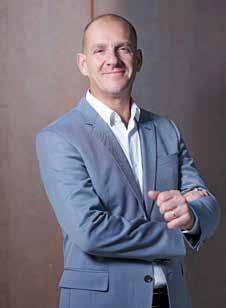
“We must work to internationally recognised ESG standards and frameworks, apply a holistic, scientific and data-driven approach, and adopt a process of continuous improvement in all pillars of ESG.”
businesses to demonstrate their ESG credentials. Businesses will need to show authorities through non-financial reporting that they influence their supply chains to make better choices. It’s likely owners and guests will be affected by these regulations through their own business and so understand the translation to this within their personal lives and yachts too.
If the survey data indicates anything, it’s that one in every two clients will be interested in sustainability. Therefore, offering genuinely effective changes and solutions could become increasingly valuable for the industry.
How can we encourage these improvements?
Despite these clear reasons, reluctance to adopt changes persists, even when they don’t significantly affect operations. How can we overcome this reluctance to enact change?
A common reason for inaction seems to be a lack of motivation or a misunderstanding about the effects on experience. Key influencers, such as brokers, designers and experienced crew, can significantly affect the choices made on board and so can be part of the solution to combat this. If these people better understand the beneficial changes that can be made, they’ll be able to explain the options available to owners and guests as well as the associated pros and cons.
For example, during a refit, when discussing potential works, options should be presented, such as those suggested by Water Revolution Foundation, to implement changes that will



reduce impact. This is similar to the approach taken by Arksen for their new builds. For my feature in the New Build Report, Ben Bowley, build captain, told me, “People aren’t going to stop buying these boats. So actually, it’s all of our responsibility to try and educate and allow people to nudge the industry in the right direction.” This exemplifies making it less about making minimal impact and more about making improvements where possible.
One survey response suggested that more sustainable practices aren’t being implemented on board due to a lack of education and the absence of quantified goals. This highlights the need for our industry to understand the ESG-related strategies, policies and procedures that superyachts should have, and how to create and implement them on board.
Blue ESG has two tailored solutions to this for superyachts, ESG Navigator and Yacht Zero. ESG Navigator is aligned with the UN’s Sustainable Development Goals (SDGs) and identifies, measures and improves a yacht’s ESG performance through environmental and socialimpact data points, which are then used to set key performance indicators (KPIs) and objectives and key results (OKRs) as well as create a score to compare with the performance of other yachts.
Yacht Zero is a superyacht emissionsmanagement programme, which includes the Superyacht Carbon Intensity Index (SCII), developed with Lloyd’s Register and based on IMO MARPOL Annex VI (CII) standards, which gives vessels a carbon-intensity rating and
One limitation to achieving significant progress is that efforts are currently very siloed and individual, relying on those individuals to see the benefits of these changes and so have the motivation to enact them.
certification. Alongside this, Blue ESG offers consultancy to help yachts reduce emissions in line with IMO GHG targets.
Marrison hopes that ESG reports for vessels, such as those created through the ESG Navigator and Yacht Zero programmes, will be used in sales discussions, envisaging a new normal where brokers provide ESG reports/ ratings, so meaning buyers have the resources and understandings available to them, leading to a better appreciation of their vessels’ environmental and social performance.
The Superyacht Eco Association has a similar aim: to provide better transparency and understanding of the environmental impact for superyacht owners and guestsby assessing vessels through its SEA Index CO2 emissions calculator and subsequently providing an operational efficiency rating for existing vessels, similar to the energyefficiency ratings for electronic goods.
If performance metrics such as these and YETI become more widespread, understanding, expectations and desires would probably shift towards betterperforming yachts, leading to more changes being implemented across the existing fleet and new-build designs. However, the question still remains whether there is enough incentive for these yachts to be rated.
As highlighted, there are many actions, initiatives and approaches that can be taken within our industry to improve the impact of yachts. However, one limitation to achieving significant progress is that efforts are currently very
siloed and individual, relying on those individuals to see the benefits of these changes and so have the motivation to enact them.
Marrison believes there’s a “lack of cohesion and a common approach on how to shape the future of the sector”. Many may feel burdened by the risks associated with being early adopters, leading to hesitancy in taking proactive measures. Consequently, many industrywide changes are reactive to new regulations enforced on the industry. There should be a more collective effort to make collaborative efforts across the industry.
Marrison says, “We must work to internationally recognised ESG standards and frameworks, apply a holistic, scientific and data-driven approach, and adopt a process of continuous improvement in all pillars of ESG.” He particularly sees this as a way to improve accountability and, therefore, the outward image of the industry to the public. Another benefit of a unified approach is that it would make our industry more resilient and future-proof in an ever-changing landscape.
Another way to overcome barriers to effective change in the industry, which Marrison hopes to see, is shifting away from enacting these improvements only at an owner’s request. Instead, providing ESG strategies and implementing some of the changes mentioned should be seen as a service to mitigate future risks and impacts that may result from inaction. MH
Guest Column
by Hanna Dąbrowska
Sustainability is no longer an optional consideration in yachting; it’s a pivotal factor that can redefine the economics of ownership, driving both ecological and financial benefits. While the upfront costs of incorporating newer, more ecofriendly technologies during a yacht’s build or refit might seem daunting, these initial investments lead to significant operational savings, both in terms of reduced running costs and a lower environmental footprint.
As the industry anticipates future regulations and potential taxes on carbon emissions, these savings become even more crucial. By embracing sustainability from the outset, yacht owners can not only reduce their environmental impact, but also position themselves for substantial cost savings in the years to come.
Reducing energy demand, implementing less impactful alternatives and optimising efficiency can both mitigate financial burdens and enhance environmental responsibility, ultimately shaping a more sustainable future for yacht ownership.
Reducing energy demand
Reducing unnecessary energy consumption is crucial for both cost
management and environmental sustainability in yacht ownership. This begins with optimising contracted parameters such as the yacht’s maximum speed, continues through decisions made during the design and construction phases and extends to enhancing propulsion efficiency and hotel functions.
Embracing a principle of ‘less is more’ can lead to significant benefits: less energy use results in reduced pollution, lower costs and decreased waste, which in turn maximises environmental advantage. Contrary to the perception that yacht owners are indifferent to sustainability, studies indicate that many are indeed eco-conscious and expect their yachts to have minimal environmental impact. Even if sustainability isn’t a primary concern for some, the incentive to reduce costs will drive the industry towards more environmental practices nonetheless.
The costs of yacht ownership are generally broken down as 40 per cent for crew management, 30 per cent for operations, five per cent for owner expenses and 25 per cent for periodic maintenance, and environmental considerations can significantly impact these spendings. By implementing voluntary emission reduction practices
and adopting sustainable behaviours – such as CO2-aware travel by crewmembers and purchasing lowfootprint on-board supplies – significant positive impact can be made.
Implementing alternative solutions
Biofuel hydrotreated vegetable oil (HVO) represents a practical and proven solution for reducing environmental impact. Although slightly more expensive than traditional fossil fuels, HVO offers reduced emissions, higher cetane numbers and better combustion efficiency. These benefits translate into potential savings on engine and generator maintenance, alongside significant reductions in the yacht’s ecological footprint.
Research by Water Revolution Foundation, in collaboration with Tetis Institute SRL (University of Genoa spinoff) and the joint industry group behind the Yacht Environmental Transparency Index (YETI), shows that HVO reduces environmental impact by at least 70 per cent compared to traditional fuels. The only challenge of implementing HVO concerns ensuring its availability and the commitment required for bunkering. Yes, the fuel is 20 per cent plus more expensive and at the moment relatively complex in terms of supply and delivery,
but those early adopters and those champions of HVO will drive more investment into the supply chain and all of the other energy-reduction initiatives will drive less consumption and fuel burn anyway.
Let’s suggest that the $100,000 of additional fuel cost seems like a big 20 per cent increase, but with smart ideas and operational innovation across all of the operating budget of millions of dollars, this number evaporates into the economic ecosphere.
Optimising energy efficiency
Another critical factor bringing big gain both to nature and the owner’s pocket is energy efficiency. Using the YETI methodology, fuel consumption is analysed in terms of specific ‘consumers’: propulsion and hotel load. Optimising propulsion can reduce energy use by up to 30 per cent compared to average yachts, leading to 30 per cent fuel savings. Similarly, optimising the hotel load can save 15 to 20 per cent in power usage, translating into lower fuel or shore power costs.
Given that fuel and port costs represent 15 to 30 per cent of annual yacht expenses and yearly ownership is approximately 10 per cent of the vessel’s value, optimising these factors offers substantial financial savings – all while saving the planet.
Regulating the yacht’s range of autonomy can also contribute to efficiency. Reducing fuel capacity leads to less volume, resistance and power demand, ultimately resulting in lower consumption and costs. This is naval architecture’s spiral of design versus decision-making. Rethinking autonomy is a key strategy in transforming the industry and fostering new fuel solutions.
The path ahead
Technological innovation alone will not suffice to meet climate goals such as those outlined in the Paris Agreement. The practical application of existing, proven solutions and research is crucial across yacht sales, design, engineering and refit processes to improve environmental performance and reduce footprints. Tools such as the YETI methodology and emerging ISO
Is the cost of building a sustainable yacht lower? Probably not –however, this initial cost must be weighed against the overall costs of yacht ownership throughout its lifecycle.

standards, combined with stakeholder engagement, can drive large-scale impact.
Is the cost of building a sustainable yacht lower? Probably not – sustainable materials are currently in high demand and come at a premium. However, this initial cost must be weighed against the overall costs of yacht ownership throughout its lifecycle.
In conclusion, it’s imperative to apply every feasible solution to reduce the yachting industry’s environmental impact and invest in regenerative programmes for maximum results. By uniting efforts and committing to more sustainable practices, we can ensure a better future for both the industry and planet at large.
Editor’s (and founding board member of Water Revolution Foundation’s) comment: Every time we speak to brokers, designers, captains, advisers and builders of the current fleet, there’s a common theme that owners are not willing to invest in the new greener technologies unless regulation dictates because the increased cost is perceived to be prohibitively expensive.
However, over the years, we’ve been advocating that more and more owners need to have better information presented to them about CAPEX and OPEX in order to explain that the investment made now for a new project will pay dividends in the long run with a reduced OPEX and more acceptance and access to remote cruising grounds in the future, when regional governments impose restrictions. If the green technology and the alternative fuels have a CAPEX increase of 20 Water Revolution Foundation and if the OPEX reduction is more than 40 Water Revolution Foundation per annum, then the environmental economics start to add up. HD
Exploring the potential of the NEOM region

The development of major marina assets over the next 10 years in the Red Sea is a breath of fresh air and will extend the traditional cruising itinerary.


BY MARTIN H. REDMAYNE
With the imminent arrival of NEOM’s first marina asset and the further development of the Red Sea projects in Saudi Arabia (KSA), from Jeddah to Jordan in the Gulf of Aqaba, I’ve affectionately named this emerging cruising ground the ‘Rediterannean’ or the “Arabbean’.
There’s a simple reason for these playful names, because in the next 10 or more years, we’re likely to witness the delivery of a dozen major marina assets and a pristine cruising ground that will extend the Med season and may even divert some attention away from the Caribbean.
When you consider the variety of factors that make a cruising ground successful – infrastructure, transport logistics, entertainment, good anchorages and accessibility – the plans in KSA have been not only ambitious, but also brave.
Anyone who visited the shoreline of KSA in the northern Red Sea, prior to 2020, just beyond the Suez Canal, would have found a stark coastal landscape with rock, desert and the occasional wadi and greenery, combined with stunning waters, untouched coral reefs and islands that are relatively unexplored. Fast forward four years and you will now find a range of construction projects, futureproofed infrastructure, large marina basins and a plethora of first-class real estate and VIP hospitality concepts emerging out of nowhere.
During the past four years, my consultancy team and I have worked with a myriad of partners in the region – CBRE, McKinsey, Deloitte, Red Sea Authority and various parts of NEOM – analysing, validating and conceptualising what this region has the potential to become as a marine eco-system and future playground of yachting.
At this stage, the coastline from Jeddah to the border of Jordan, combined with the Egyptian coastline and the exit of the Suez Canal into the Red Sea, represents a cruising ground about the same size as the Adriatic. Then considering the cruising distance from Antibes to Malta, it’s almost identical to the distance from Athens to NEOM, which puts into context how this region can become an extension of the Mediterranean.
It’s going to be feasible, providing the Suez Canal Authority and the Red Sea Authority create safe and efficient passage, that a yacht entering through the Straits of Gibraltar in early March could in fact cruise for nearly 10 months of the year, with Western Med, Eastern Med and now Northern Red being part of the cruising pattern.
Additionally, the Indian Ocean, with the Maldives and Seychelles (and when the situation in the Yemen has settled), presents an interesting opportunity for owners and guests to enjoy 12 months of cruising in less than two per cent of


Let’s be clear. This isn’t just a winter cruising ground, it’s a gateway east from the Mediterranean into new territories, exposing our sector to new investors and yacht owners.
the world’s oceans. So, rather than a Med season from June to September, there will be a series of quarterly seasons that shift the dial on occupancy and usage of yachts, potentially delivering more charter opportunities and more owner use beyond the norm.
For a clear understanding of what’s happening in the Northern Red Sea, it’s useful to look beyond the PR machines and the press content and observe closely what the PIF Saudi mission looks like. It has a clear mandate coming from the top – tourism, tourism, tourism as well as myriad investments into cash-generating financial projects and futurethinking stuff – but the dream of building a series of assets and landmarks that are going to attract millions of luxury tourists to KSA is firmly on the agenda.
With several thousand luxury hotel rooms, a few thousand villas and mansions dotted along the coastline among brand new luxury communities that resemble Porto Cervo on steroids, the Red Sea could soon become the next UHNWI playground –not just for KSA residents, but also for a whole new gathering of billionaires and millionaires.
More than 5,000 yacht berths are being planned and built within marina eco-systems that have been designed by starchitects and visual creatives from the film sets of Hollywood. Private and public islands are being developed and curated as new yachting hubs for golfers, divers and sailors from around the world, the first of which, NEOM Sindalah Island, will be soft-launched in October.
It will be absolutely fascinating to watch this eco system come on line and to see how yachting interacts with it. Will it be a feeding frenzy or will there be a mutual respect where everyone wants to make this new territory work and not be just a shortterm cash cow.
After the delivery of Sindalah, as the first yachting asset in NEOM, alongside the projects in and around Jeddah, we’ll see projects such as Jaumur, Aquellum, Norlana, the Hidden Marina, Shushah Island, Oxagon, Amaala and many more real-estate and marine eco systems come on stream between 2025 and 2040.
So, in essence, this is a long game and we all have to be patient with this new cruising ground, but it’s fair to say that this is one of the most exciting marina infrastructure projects to appear on our planet and could shape the future of our traditional cruising grounds.
Let’s be clear. This isn’t just a winter cruising ground, it’s a gateway east from the Mediterranean into new territories, exposing our sector to new investors and yacht owners. Russia, India, Asia and the whole of the GCC have an opportunity to make the Red Sea and the Gulf/Indian Ocean their playground in the same way that is already happening fiscally and in the real-estate world. Culturally, these clients have different usage profiles and cycles, holidays, demands, pastimes and expectations, so this isn’t just a plug and play of the traditional yacht owner and charter client. Yes, the European and US owners will be very welcome and able to explore this brave new world, but there will be a nuance that will be both exciting and different from a cruising and lifestyle perspective.
When Sindalah is open for business in Q4 of this year, with its unique underwater world, combined with first-class on-land deliverables of food and beverage, golf, hospitality and beach activity, it’s important to recognise that only a small percentage of the fleet can enjoy this new marina asset. This is, in some ways, a good thing because the real-estate operators, marina managers and the various investors and authorities can learn from
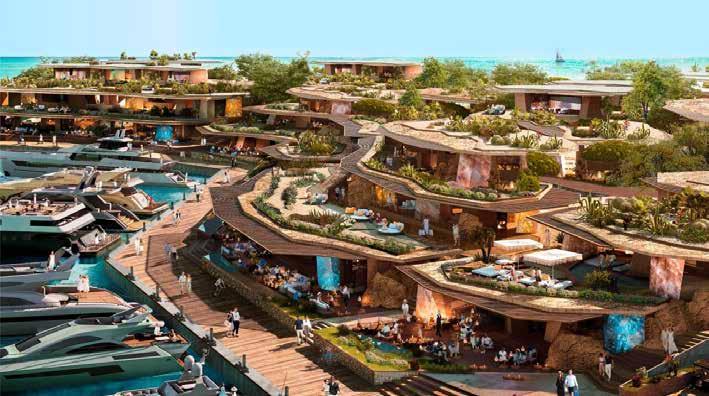
This network of marina assets, pristine cruising grounds and culturally exciting land-based projects will make the Red Sea one of the most exciting new playgrounds for the yachting sector.
the first movers in order to refine and improve their offering.
The fact that all this new infrastructure will take a decade or more to come to maturity is perhaps also a good thing, and during this evolution, we’ll all learn to work with the Suez Canal and Red Sea Authorities. We will learn how to play with a new coastline that doesn’t have the same bays, anchorages and beaches that we know and love in the Med, accompanied by the architectural developments that are being built as the new lifestyle destinations for owners and guests to experience.
In conclusion, this is not only a fascinating series of projects to be directly involved with, but you can also see how this network of marina assets,
pristine cruising grounds and culturally exciting land-based projects will make the Red Sea one of the most exciting new playgrounds for the yachting sector. This combination of marina investment, the potential demand from new owners and users to experience yachting at all levels, the extension of the cruising calendar and a sensitive but stunning marine eco-system is a rare and challenging mix.
The benchmarks and lessons learned from the Caribbean and the Mediterranean should help the investors, developers, authorities and communities to benefit from our mistakes and create a destination that is well managed, protected and sympathetic to what is an incredible location with new discoveries and experiences that will hopefully give owners and their guests something very exciting not far from our maritime doorstep.
Having witnessed the weather systems in the Med this summer, from Ibiza to Mykonos, Monaco to Porto Cervo, the storms, winds, rain torrents, fires, groundings, collisions and other issues, it’s made me consider the congestion and overcrowding topic of luxury-yachting tourism. Perhaps the additional cruising ground with new marina assets and pristine water, will be a breath of fresh air and will add a few more weeks to the cruising itinerary. Let’s just not assume that this will be more of the Mediterranean and let’s respect the culture and opportunity that KSA is developing. MHR


There’s an inconvenient truth that many owners still seem to overlook in yachting … and that’s the necessary investment in safety and crew.
Investing in crew is more vital now than ever before. We’ve all seen the consequences of insufficient competency in the wider world, with the likes of the Grenfell Tower fire and the findings in the subsequent report of it being a tragic example of what happens when corners are cut. While some may argue that the stakes may differ in yachting, we’ve just seen that the risks are all too real with the Bayesian tragedy.
Now, my job isn’t to speculate and, considering the controversial circumstances of the disaster and the conspiracy-theory fall-out that has ensued, it’s not the example I’m going to use. It does, however, follow a spate of incidents I’ve covered in the past few months that seemed utterly avoidable if the correct procedures were followed and crew competency was higher. This isn’t a slight on them either; the pressures and workload they are under are well documented. I’m merely addressing the elephant in the room. The reality is that yachting has become more complex. Larger vessels, increasingly sophisticated technology and stricter regulations require crew who are more skilled than ever before. The lack of investment in crew training not only jeopardises safety, but also has far-reaching consequences, affecting everything from the wider perception of yachting, insurance premiums and credit ratings to the overall well-being and happiness of the captain and crew. An industry is only as good as the people who operate it, and this is where owners must step up.

BY CONOR FEASEY
I understand it’s a difficult conversation to have. Private owners often expect their crew to come ready prepped and primed for any and all situations. They aren’t cheap, after all. Commercial charter owners have similar expectations, and the loss of a million or so euros from charter revenue might seem like too high a price to pay but, in truth, money isn’t everything, and yachting shouldn’t be purely driven by financial gains or mitigating losses.
It’s not just about keeping insurers happy either. Investing in training also fosters a positive working environment,
which makes crew more likely to stay. In an industry that already suffers from a shortage of highly qualified crew, providing opportunities for skill development is a win-win. It creates loyalty, improves morale and encourages a higher standard of service. In the end, investing in crew isn’t just about safety or regulatory compliance, it’s about building an environment where the crew feel valued, skilled and motivated.
From a financial perspective, failing to invest in enhanced safety systems and training will begin to garner significant implications. Insurers are already tightening their policies, particularly in the wake of high-profile incidents that could have been avoided with bettertrained staff.
The cost of not providing adequate training will be felt in rising premiums and potentially denied claims. Moreover, these recent incidents are likely to cause a gold rush for the latest on-board safety systems and will have sizeable implications on the supply chain. And let’s not forget the impact on credit lenders who may see yachts as higher risk, making it more difficult to secure favourable financing in the future.
The industry, now more than ever, depends on owners who are willing to invest in its backbone. Owners must embrace this responsibility, both for their own benefit and the future of yachting itself, and those who view crew development and safety equipment as a loss of revenue aren’t seeing the bigger picture. The immediate costs of sending crew for training pale in comparison to the long-term benefits of having a competent, well-prepared team.
Safety improves, operations run more smoothly and the yacht maintains its value. After all, a well-trained crew is the most critical component in ensuring a yacht functions as it should. The inconvenient truth is that cutting corners on crew training might save money in the short term but it will undoubtedly cost more in the long run. And any loss of life is too big a price to pay. CF
and Best Sailing Yacht of 40m and above / World Superyacht Awards 2024
And winner of 5 more awards: Best Interior, Best Exterior, Best Naval Architecture, Eco Award, Innovation of the Year Design & Innovation Awards 2024
